
This is a list of the bird species recorded in Chile. Unless otherwise noted, the list is that of the South American Classification Committee (SACC) of the
American Ornithological Society
The American Ornithological Society (AOS) is an ornithological organization based in the United States. The society was formed in October 2016 by the merger of the American Ornithologists' Union (AOU) and the Cooper Ornithological Society. Its ...
. The SACC list includes species recorded in mainland
Chile
Chile, officially the Republic of Chile, is a country in the western part of South America. It is the southernmost country in the world, and the closest to Antarctica, occupying a long and narrow strip of land between the Andes to the eas ...
, on the Chilean islands of the Cape Horn area, on other islands and waters near the mainland, and on and around the
Juan Fernández Islands
The Juan Fernández Islands ( es, Archipiélago Juan Fernández) are a sparsely inhabited series of islands in the South Pacific Ocean reliant on tourism and fishing. Situated off the coast of Chile, they are composed of three main volcanic i ...
. The list's
taxonomic treatment (designation and sequence of orders, families, and species) and nomenclature (common and scientific names) are also those of the SACC.
[Remsen, J. V., Jr., J. I. Areta, E. Bonaccorso, S. Claramunt, A. Jaramillo, D. F. Lane, J. F. Pacheco, M. B. Robbins, F. G. Stiles, and K. J. Zimmer. Version 31 January 2022. A classification of the bird species of South America. American Ornithological Society. https://www.museum.lsu.edu/~Remsen/SACCBaseline.htm retrieved 1 February 2022]
According to the SACC, the avifauna of Chile has 519 confirmed species, of which 12 are
endemic
Endemism is the state of a species being found in a single defined geographic location, such as an island, state, nation, country or other defined zone; organisms that are indigenous to a place are not endemic to it if they are also found els ...
, 122 are rare or
vagrants
Vagrancy is the condition of homelessness without regular employment or income. Vagrants (also known as bums, vagabonds, rogues, tramps or drifters) usually live in poverty and support themselves by begging, scavenging, petty theft, tem ...
, six have been
introduced by humans, and one is
extinct . An additional eight species are hypothetical (see below). One additional vagrant species is added from another source. Thirty-five of the species on the Chilean SACC list are globally threatened.
The following tags have been used to highlight several categories.
* (V) Vagrant - a species that rarely or accidentally occurs in Chile
* (E) Endemic - a species endemic to Chile
* (I) Introduced - a species introduced to Chile as a consequence, direct or indirect, of human actions
* (H) Hypothetical - a species recorded but with "no tangible evidence" according to the SACC
Rheas

Order:
RheiformesFamily:
Rheidae
The rheas are large flightless birds native to South America. Their feet have three toes rather than four which allows them to run faster. One species has been recorded in Chile.
*
Lesser rhea
Darwin's rhea or the lesser rhea (''Rhea pennata'') is a large flightless bird, the smaller of the two extant species of rheas. It is found in the Altiplano and Patagonia in South America.
Description
The lesser rhea stands at tall. Lengt ...
, ''Rhea pennata''
Tinamous
Order:
TinamiformesFamily:
Tinamidae
The tinamous are one of the most ancient groups of birds. Although they look similar to other ground-dwelling birds like quail and grouse, they have no close relatives and are classified as a single family, Tinamidae, within their own order, the Tinamiformes. They are distantly related to the
ratites
A ratite () is any of a diverse group of flightless, large, long-necked, and long-legged birds of the infraclass Palaeognathae. Kiwi, the exception, are much smaller and shorter-legged and are the only nocturnal extant ratites.
The systematics ...
(order
Struthioniformes), that includes the
rheas,
emu
The emu () (''Dromaius novaehollandiae'') is the second-tallest living bird after its ratite relative the ostrich. It is endemic to Australia where it is the largest native bird and the only extant member of the genus '' Dromaius''. The ...
s, and
kiwi
Kiwi most commonly refers to:
* Kiwi (bird), a flightless bird native to New Zealand
* Kiwi (nickname), a nickname for New Zealanders
* Kiwifruit, an edible berry
* Kiwi dollar or New Zealand dollar, a unit of currency
Kiwi or KIWI may also ref ...
s. Six species have been recorded in Chile.
*
Ornate tinamou
The ornate tinamou (''Nothoprocta ornata'') is a type of tinamou commonly found in the high altitude grassland and dry shrubland in subtropical and tropical regions of west central South America.Clements, J. (2007)
Etymology
''Nothoprocta'' co ...
, ''Nothoprocta ornata''
*
Chilean tinamou, ''Nothoprocta perdicaria'' (E)
*
Andean tinamou
The Andean tinamou (''Nothoprocta pentlandii'') is a tinamou, found commonly in high-altitude shrubland, in the Andes of South America.Clements, J. (2007)
Taxonomy
All tinamou are from the family Tinamidae, and in the larger scheme are also rati ...
, ''Nothoprocta pentlandii''
*
Elegant crested-tinamou, ''Eudromia elegans''
*
Puna tinamou
The puna tinamou (''Tinamotis pentlandii'') also known as Pentland's tinamou, is a member of the most ancient groups of bird families, the tinamous. This species is native to southern South America.Clements, J. (2007) The binomial name of the s ...
, ''Tinamotis pentlandii''
*
Patagonian tinamou, ''Tinamotis ingoufi''
Ducks


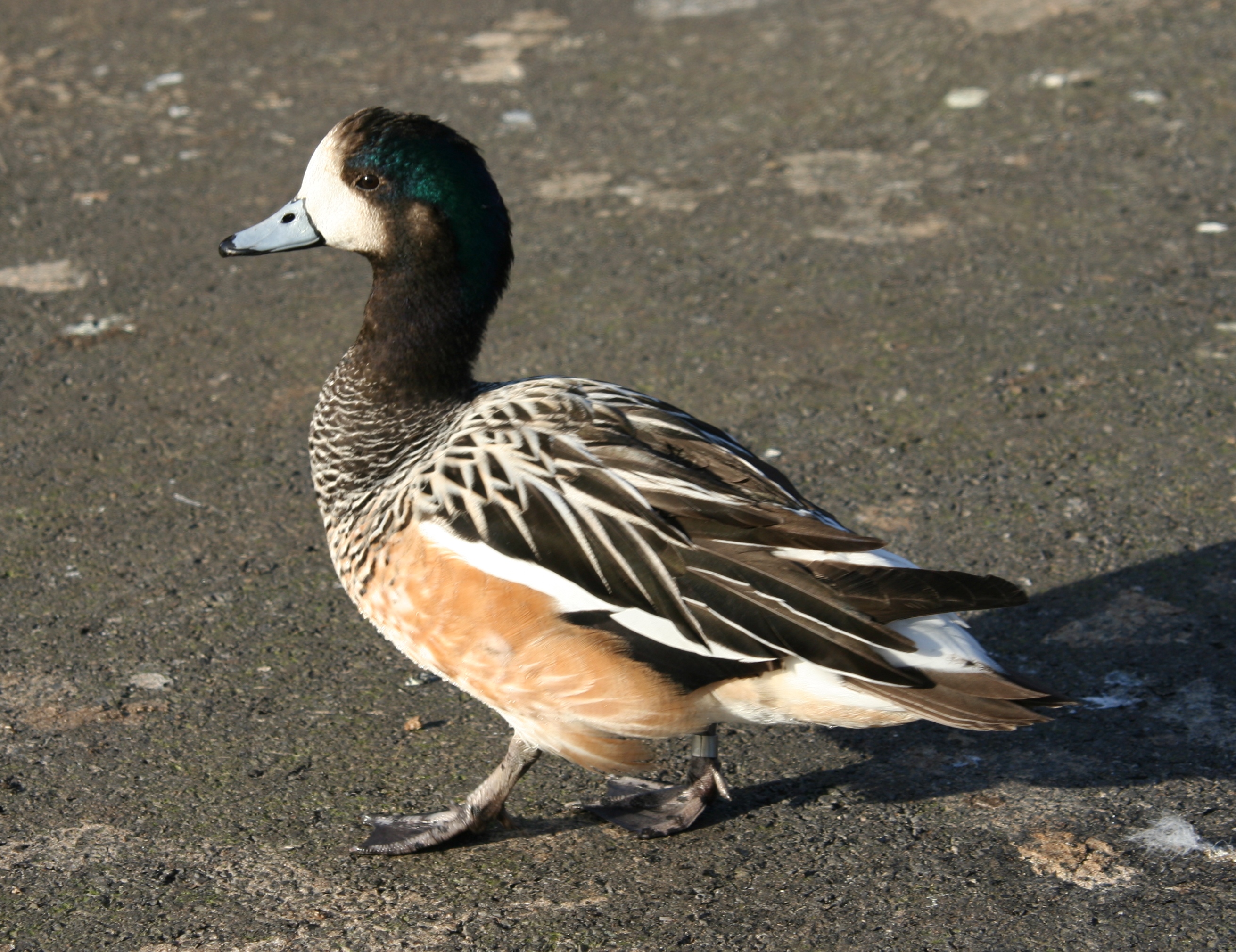
Order:
Anseriformes
Anseriformes is an order of birds also known as waterfowl that comprises about 180 living species of birds in three families: Anhimidae (three species of screamers), Anseranatidae (the magpie goose), and Anatidae, the largest family, which in ...
Family:
Anatidae
The Anatidae are the biological family of water birds that includes ducks, geese, and swans. The family has a cosmopolitan distribution, occurring on all the world's continents except Antarctica. These birds are adapted for swimming, floating ...
Anatidae includes the
duck
Duck is the common name for numerous species of waterfowl in the family Anatidae. Ducks are generally smaller and shorter-necked than swans and geese, which are members of the same family. Divided among several subfamilies, they are a fo ...
s and most duck-like waterfowl, such as
geese
A goose ( : geese) is a bird of any of several waterfowl species in the family Anatidae. This group comprises the genera ''Anser'' (the grey geese and white geese) and '' Branta'' (the black geese). Some other birds, mostly related to the she ...
and
swan
Swans are birds of the family Anatidae within the genus ''Cygnus''. The swans' closest relatives include the geese and ducks. Swans are grouped with the closely related geese in the subfamily Anserinae where they form the tribe Cygnini. Sometim ...
s. These birds are adapted to an aquatic existence with webbed feet, flattened bills, and feathers that are excellent at shedding water due to an oily coating. Twenty-nine species have been recorded in Chile.
*
Fulvous whistling-duck
The fulvous whistling duck or fulvous tree duck (''Dendrocygna bicolor'') is a species of whistling duck that breeds across the world's tropical regions in much of Mexico and South America, the West Indies, the southern United States, sub-Saha ...
, ''Dendrocygna bicolor'' (V)
*
White-faced whistling-duck, ''Dendrocygna viduata'' (V)
*
Black-bellied whistling-duck, ''Dendrocygna autumnalis'' (V)
*
Black-necked swan
The black-necked swan (''Cygnus melancoryphus'') is a species of waterfowl in tribe Cygnini of subfamily Anserinae.HBW and BirdLife International (2021) Handbook of the Birds of the World and BirdLife International digital checklist of the bir ...
, ''Cygnus melancoryphus''
*
Coscoroba swan, ''Coscoroba coscoroba''
*
Andean goose
The Andean goose (''Chloephaga melanoptera'') is a species of waterfowl in tribe Tadornini of subfamily Anserinae.HBW and BirdLife International (2021) Handbook of the Birds of the World and BirdLife International digital checklist of the bir ...
, ''Oressochen melanoptera''
*
Upland goose, ''Chloephaga picta''
*
Kelp goose, ''Chloephaga hybrida''
*
Ashy-headed goose, ''Chloephaga poliocephala''
*
Ruddy-headed goose, ''Chloephaga rubidiceps''
*
Comb duck, ''Sarkidiornis sylvicola'' (V)
*
Torrent duck
The torrent duck (''Merganetta armata'') is a member of the duck, goose and swan family Anatidae. It is the only member of the genus ''Merganetta''. It is placed in the shelduck subfamily Tadorninae after the " perching duck" assemblage to which ...
, ''Merganetta armata''
*
Flying steamer-duck, ''Tachyeres patachonicus''
*
Flightless steamer-duck, ''Tachyeres pteneres''
*
Crested duck, ''Lophonetta specularioides''
*
Spectacled duck, ''Speculanas specularis''
*
Puna teal, ''Spatula puna''
*
Silver teal, ''Spatula versicolor''
*
Red shoveler, ''Spatula platalea''
*
Blue-winged teal
The blue-winged teal (''Spatula discors'') is a species of bird in the duck, goose, and swan family Anatidae. One of the smaller members of the dabbling duck group, it occurs in North America, where it breeds from southern Alaska to Nova Scotia, ...
, ''Spatula discors'' (V)
*
Cinnamon teal
The cinnamon teal (''Spatula cyanoptera'') is a species of duck found in western North and South America. It is a small dabbling duck, with bright reddish plumage on the male and duller brown plumage on the female. It lives in marshes and ponds, ...
, ''Spatula cyanoptera''
*
Chiloe wigeon, ''Mareca sibilatrix''
*
White-cheeked pintail, ''Anas bahamensis''
*
Yellow-billed pintail
The yellow-billed pintail (''Anas georgica'') is a South American dabbling duck of the genus ''Anas'' with three described subspecies.
Taxonomy
The yellow-billed pintail was formally described in 1789 by the German naturalist Johann Friedrich ...
, ''Anas georgica''
*
Yellow-billed teal
The yellow-billed teal (''Anas flavirostris'') is a South American species of duck. Like other teals, it belongs to the diverse genus ''Anas''; more precisely it is one of the "true" teals of subgenus ''Nettion''. It occurs in Argentina, the Fa ...
, ''Anas flavirostris''
*
Rosy-billed pochard, ''Netta peposaca''
*
Black-headed duck, ''Heteronetta atricapilla''
*
Ruddy duck
The ruddy duck (''Oxyura jamaicensis'') is a duck from North America and one of the stiff-tailed ducks. The genus name is derived from Ancient Greek ''oxus'', "sharp", and ''oura'', "tail", and ''jamaicensis'' is "from Jamaica".
Taxonomy
The ...
, ''Oxyura jamaicensis'' (the local subspecies is also called Andean duck)
*
Lake duck
The lake duck (''Oxyura vittata'') is a small, South American stiff-tailed duck. It is also called the Argentine blue-bill, Argentine blue-billed duck, Argentine lake duck, or Argentine ruddy duck.
Description
The lake duck grows to . Females ...
, ''Oxyura vittata''
New World quails
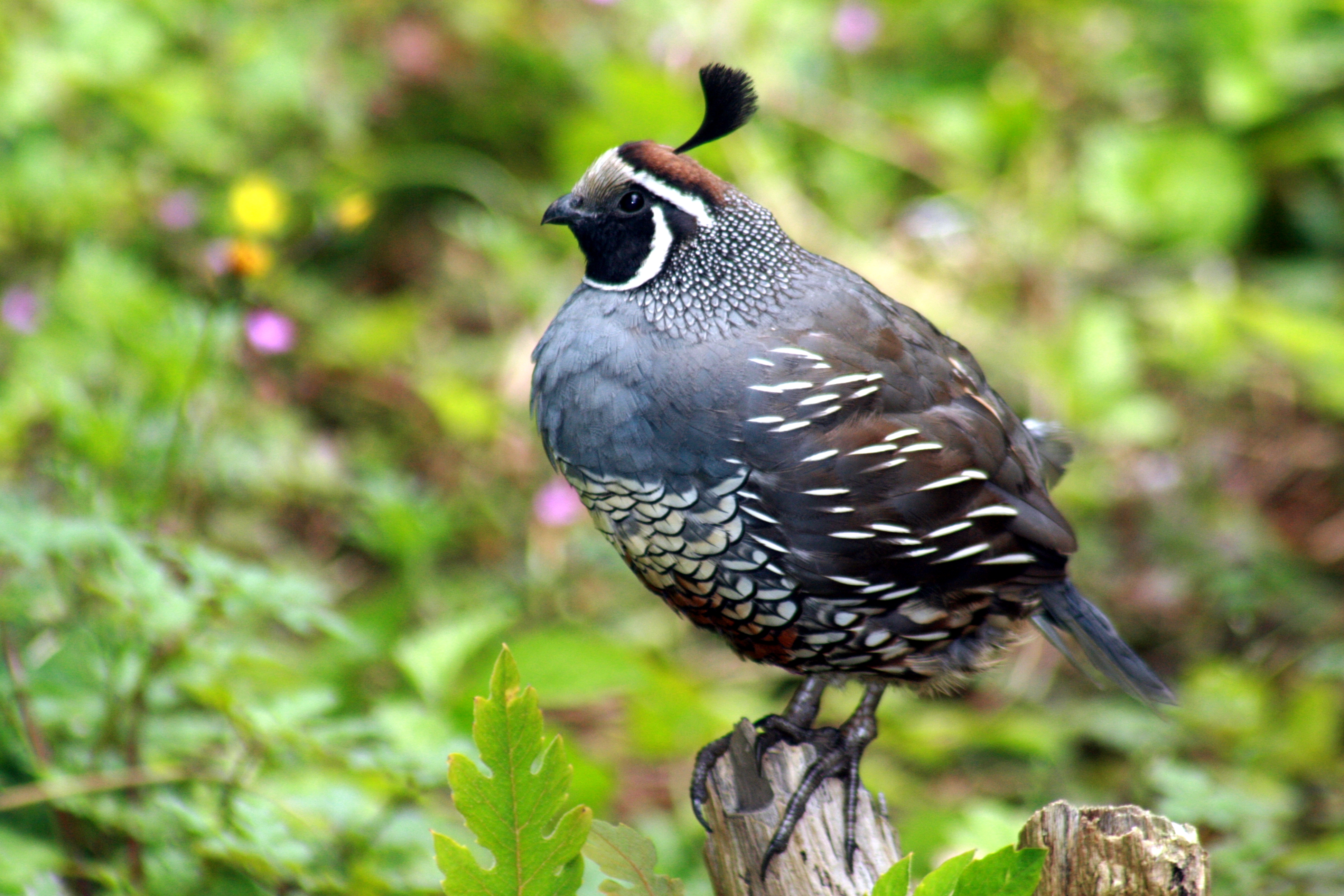
Order:
Galliformes
Galliformes is an order of heavy-bodied ground-feeding birds that includes turkeys, chickens, quail, and other landfowl. Gallinaceous birds, as they are called, are important in their ecosystems as seed dispersers and predators, and are ofte ...
Family:
Odontophoridae
The
New World quail
The New World quail are small birds only distantly related to the Old World quail, but named for their similar appearance and habits. The American species are in their own family, the Odontophoridae, whereas Old World quail are in the pheasant ...
s are small, plump terrestrial birds only distantly related to the quails of the Old World, but named for their similar appearance and habits. One species has been recorded in Chile.
*
California quail
The California quail (''Callipepla californica''), also known as the California valley quail or Valley quail, is a small ground-dwelling bird in the New World quail family. These birds have a curving crest or '' plume'', made of six feathers, th ...
, ''Callipepla californica'' (I)
Pheasants
Order:
Galliformes
Galliformes is an order of heavy-bodied ground-feeding birds that includes turkeys, chickens, quail, and other landfowl. Gallinaceous birds, as they are called, are important in their ecosystems as seed dispersers and predators, and are ofte ...
Family:
Phasianidae
The Phasianidae are a family of heavy, ground-living birds, which includes pheasants, partridges, junglefowl, chickens, turkeys, Old World quail, and peafowl. The family includes many of the most popular gamebirds. The family is a large one and i ...
The Phasianidae are a family of terrestrial birds which consists of
quail
Quail is a collective name for several genera of mid-sized birds generally placed in the order Galliformes. The collective noun for a group of quail is a flock, covey, or bevy.
Old World quail are placed in the family Phasianidae, and New ...
s,
partridge
A partridge is a medium-sized galliform bird in any of several genera, with a wide native distribution throughout parts of Europe, Asia and Africa. Several species have been introduced to the Americas. They are sometimes grouped in the Perdic ...
s,
snowcocks,
francolin
Francolins are birds in the tribe Gallini that traditionally have been placed in the genus ''Francolinus'', but now commonly are divided into multiple genera.
As previously defined, they were paraphyletic as the genus '' Pternistis'', which wa ...
s,
spurfowls,
tragopan
''Tragopan'' is a bird genus in the pheasant family Phasianidae. Member of the genus are commonly called "horned pheasants" because males have two brightly colored, fleshy horns on their head that can be erected during courtship displays. The ha ...
s,
monals,
pheasant
Pheasants ( ) are birds of several genera within the family Phasianidae in the order Galliformes. Although they can be found all over the world in introduced (and captive) populations, the pheasant genera native range is restricted to Eurasia ...
s,
peafowl
Peafowl is a common name for three bird species in the genera '' Pavo'' and '' Afropavo'' within the tribe Pavonini of the family Phasianidae, the pheasants and their allies. Male peafowl are referred to as peacocks, and female peafowl are re ...
s and
jungle fowls. In general, they are plump (although they vary in size) and have broad, relatively short wings. One species has been recorded in Chile.
*
Ring-necked pheasant, ''Phasianus colchicus'' (I)
Flamingos

Order:
PhoenicopteriformesFamily:
Phoenicopteridae
Flamingo
Flamingos or flamingoes are a type of wading bird in the family Phoenicopteridae, which is the only extant family in the order Phoenicopteriformes. There are four flamingo species distributed throughout the Americas (including the Caribbean) ...
s are gregarious wading birds, usually tall, found in both the Western and Eastern Hemispheres. Flamingos filter-feed on shellfish and algae. Their oddly-shaped beaks are specially adapted to separate mud and silt from the food they consume and, uniquely, are used upside-down. Three species have been recorded in Chile.
*
Chilean flamingo
The Chilean flamingo (''Phoenicopterus chilensis'') is a species of large flamingo at closely related to the American flamingo and the greater flamingo, with which it was sometimes considered conspecific. The species is listed as near threatene ...
, ''Phoenicopterus chilensis''
*
Andean flamingo
The Andean flamingo (''Phoenicoparrus andinus'') is a species of flamingo native to the Andes mountains of South America. Until 2014, it was classified in genus ''Phoenicopterus''. It is closely related to James's flamingo, and the two make up th ...
, ''Phoenicoparrus andinus''
*
James's flamingo (Puna flamingo), ''Phoenicoparrus jamesi''
Grebes
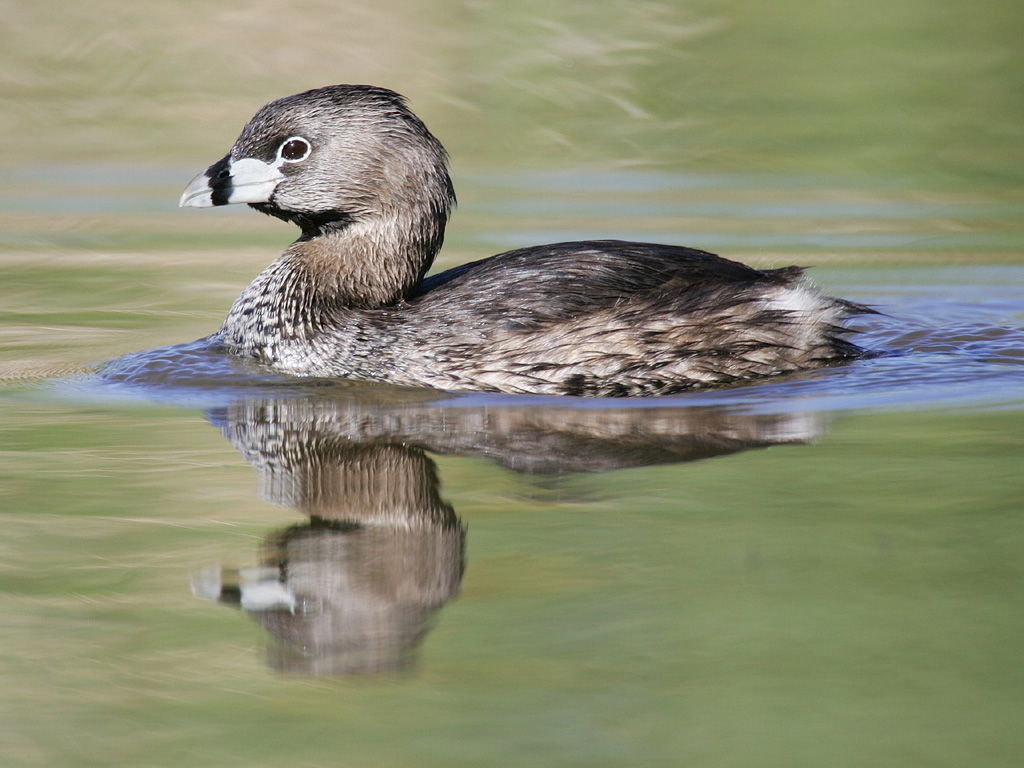
Order:
PodicipediformesFamily:
Podicipedidae
Grebe
Grebes () are aquatic diving birds in the order Podicipediformes . Grebes are widely distributed freshwater birds, with some species also found in marine habitats during migration and winter. Some flightless species exist as well, most notably ...
s are small to medium-large freshwater diving birds. They have lobed toes and are excellent swimmers and divers. However, they have their feet placed far back on the body, making them quite ungainly on land. Five species have been recorded in Chile.
*
White-tufted grebe, ''Rollandia rolland''
*
Pied-billed grebe, ''Podilymbus podiceps''
*
Great grebe, ''Podiceps major''
*
Silvery grebe, ''Podiceps occipitalis''
*
Hooded grebe, ''Podiceps gallardoi'' (V)
Pigeons
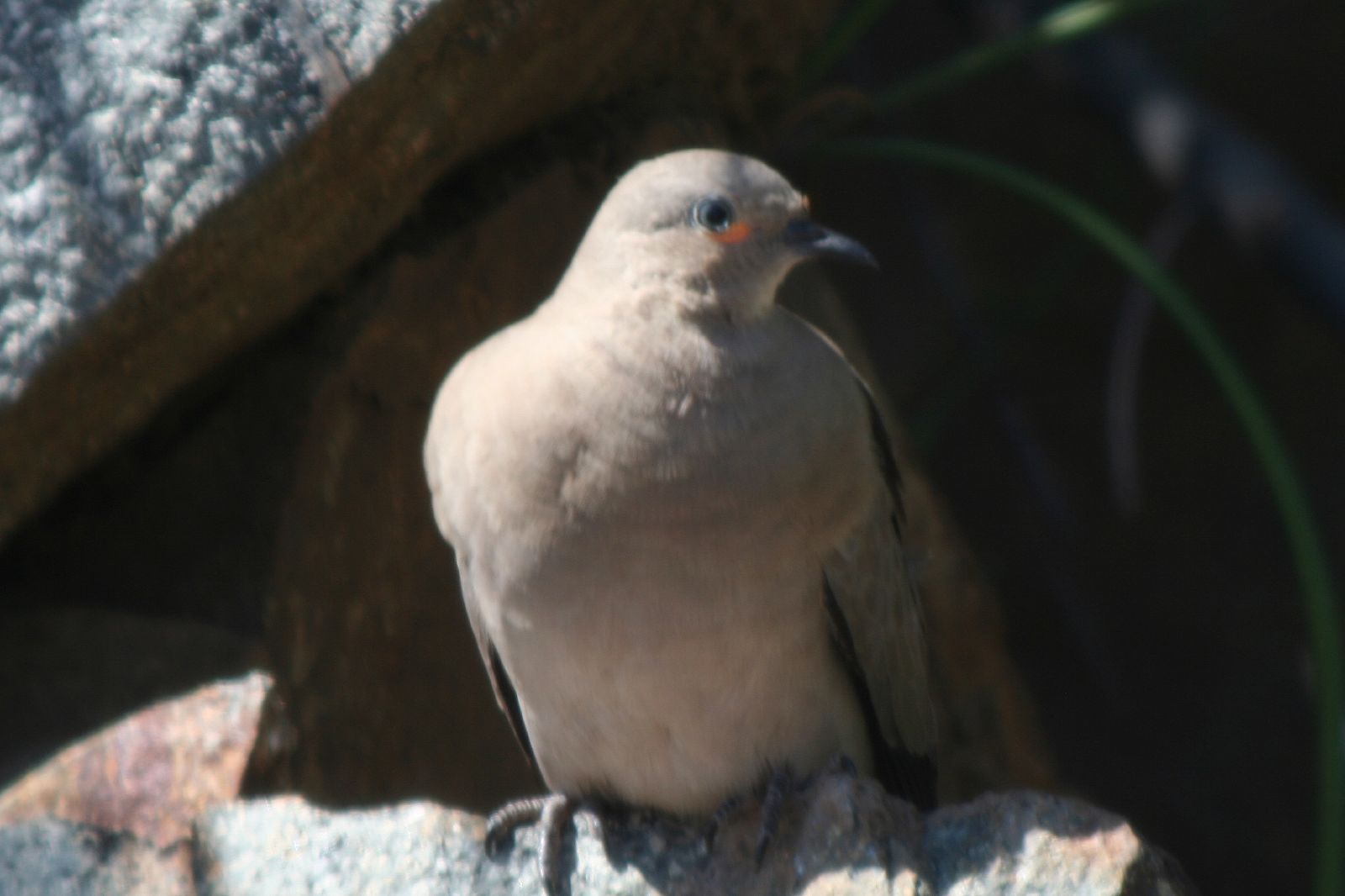
Order:
ColumbiformesFamily:
Columbidae
Columbidae () is a bird family consisting of doves and pigeons. It is the only family in the order Columbiformes. These are stout-bodied birds with short necks and short slender bills that in some species feature fleshy ceres. They primarily ...
Pigeon
Columbidae () is a bird family consisting of doves and pigeons. It is the only family in the order Columbiformes. These are stout-bodied birds with short necks and short slender bills that in some species feature fleshy ceres. They primarily ...
s and
dove
Columbidae () is a bird family consisting of doves and pigeons. It is the only family in the order Columbiformes. These are stout-bodied birds with short necks and short slender bills that in some species feature fleshy ceres. They primaril ...
s are stout-bodied birds with short necks and short slender bills with a fleshy
cere
The beak, bill, or rostrum is an external anatomical structure found mostly in birds, but also in turtles, non-avian dinosaurs and a few mammals. A beak is used for eating, preening, manipulating objects, killing prey, fighting, probing for food, ...
. Twelve species have been recorded in Chile.
*
Rock pigeon
The rock dove, rock pigeon, or common pigeon ( also ; ''Columba livia'') is a member of the bird family Columbidae (doves and pigeons). In common usage, it is often simply referred to as the "pigeon".
The domestic pigeon (''Columba livia dome ...
, ''Columba livia'' (I)
*
Picazuro pigeon
The picazuro pigeon (''Patagioenas picazuro'') is a pigeon native to South America.
Description
It is a large pigeon with a wingspan of up to 22 inches and can weigh as much as a pound. It is a brown bird with white dashes on the back of its ne ...
, ''Patagioenas picazuro'' (V)
*
Spot-winged pigeon, ''Patagioenas maculosa''
*
Chilean pigeon, ''Patagioenas araucana''
*
West Peruvian dove, ''Zenaida meloda''
*
Eared dove, ''Zenaida auriculata''
*
Bare-faced ground dove, ''Metriopelia ceciliae''
*
Black-winged ground dove
The black-winged ground dove (''Metriopelia melanoptera'') is a species of bird in the family Columbidae. It is found in Argentina, Bolivia, Chile, Colombia, Ecuador, and Peru.
Taxonomy and systematics
The black-winged ground dove has two sub ...
, ''Metriopelia melanoptera''
*
Golden-spotted ground dove
The golden-spotted ground dove (''Metriopelia aymara'') is a species of bird in the family Columbidae. It is found in Argentina, Bolivia, Chile, and Peru.
Taxonomy and systematics
The golden-spotted ground dove was placed in the monotypic gen ...
, ''Metriopelia aymara''
*
Ruddy ground dove, ''Columbina talpacoti'' (V)
*
Picui ground dove, ''Columbina picui''
*
Croaking ground dove, ''Columbina cruziana''
Cuckoos

Order:
CuculiformesFamily:
Cuculidae
The family Cuculidae includes
cuckoo
Cuckoos are birds in the Cuculidae family, the sole taxon in the order Cuculiformes . The cuckoo family includes the common or European cuckoo, roadrunners, koels, malkohas, couas, coucals and anis. The coucals and anis are sometimes separat ...
s,
roadrunners and
anis
Anis ( ar, أنيس) is a masculine given name. The meaning of the name Anis is "genial" or "close friend".
People In arts
* Anis Mohamed Youssef Ferchichi, German rapper known as Bushido
* Anis Haffar, educational theorist, teacher, columnist ...
. These birds are of variable size with slender bodies, long tails, and strong legs. Four species have been recorded in Chile.
*
Smooth-billed ani, ''Crotophaga ani'' (V)
*
Groove-billed ani
The groove-billed ani (''Crotophaga sulcirostris'') is a tropical bird in the cuckoo family with a long tail and a large, curved beak. It is a resident species throughout most of its range, from southern Texas, central Mexico and The Bahamas, thr ...
, ''Crotophaga sulcirostris''
*
Dark-billed cuckoo, ''Coccyzus melacoryphus'' (V)
*
Yellow-billed cuckoo
The yellow-billed cuckoo (''Coccyzus americanus'') is a cuckoo. Common folk-names for this bird in the southern United States are rain crow and storm crow. These likely refer to the bird's habit of calling on hot days, often presaging rain or t ...
, ''Coccyzus americanus'' (V)
Oilbird
Order:
SteatornithiformesFamily:
Steatornithidae
The oilbird is a slim, long-winged bird related to the nightjars. It is nocturnal and a specialist feeder on the fruit of the
oil palm
''Elaeis'' () is a genus of palms containing two species, called oil palms. They are used in commercial agriculture in the production of palm oil. The African oil palm '' Elaeis guineensis'' (the species name ''guineensis'' referring to its co ...
.
*
Oilbird, ''Steatornis caripensis'' (V)
Potoos
Order:
NyctibiiformesFamily:
Nyctibiidae
The potoos (sometimes called poor-me-ones) are large
near passerine birds related to the nightjars and frogmouths. They are nocturnal insectivores that lack the bristles around the mouth found in the true nightjars. One species has been recorded in Chile.
*
Common potoo, ''Nyctibius griseus'' (V)
Nightjars
Order:
Caprimulgiformes
Nightjars are medium-sized nocturnal or crepuscular birds in the family Caprimulgidae and order Caprimulgiformes, characterised by long wings, short legs, and very short bills. They are sometimes called goatsuckers, due to the ancient folk tal ...
Family:
Caprimulgidae
Nightjar
Nightjars are medium-sized nocturnal or crepuscular birds in the family Caprimulgidae and order Caprimulgiformes, characterised by long wings, short legs, and very short bills. They are sometimes called goatsuckers, due to the ancient folk tal ...
s are medium-sized nocturnal birds that usually nest on the ground. They have long wings, short legs and very short bills. Most have small feet, of little use for walking, and long pointed wings. Their soft plumage is camouflaged to resemble bark or leaves. Five species have been recorded in Chile.
*
Nacunda nighthawk, ''Chordeiles nacunda'' (V)
*
Lesser nighthawk, ''Chordeiles acutipennis'' (V)
*
Common nighthawk
The common nighthawk (''Chordeiles minor'') is a medium-sized crepuscular or nocturnal bird of the Americas within the nightjar family, whose presence and identity are best revealed by its vocalization. Typically dark (gray, black and brown), d ...
, ''Chordeiles minor'' (V)
*
Band-winged nightjar, ''Systellura longirostris''
*
Tschudi's nightjar, ''Systellura decussata''
Swifts
Order:
Apodiformes
Traditionally, the bird order Apodiformes contained three living families: the swifts (Apodidae), the treeswifts (Hemiprocnidae), and the hummingbirds (Trochilidae). In the Sibley-Ahlquist taxonomy, this order is raised to a superorder Apo ...
Family:
Apodidae
The swifts are a family, Apodidae, of highly aerial birds. They are superficially similar to swallows, but are not closely related to any passerine species. Swifts are placed in the order Apodiformes with hummingbirds. The treeswifts are closely ...
Swift
Swift or SWIFT most commonly refers to:
* SWIFT, an international organization facilitating transactions between banks
** SWIFT code
* Swift (programming language)
* Swift (bird), a family of birds
It may also refer to:
Organizations
* SWIFT ...
s are small birds which spend the majority of their lives flying. These birds have very short legs and never settle voluntarily on the ground, perching instead only on vertical surfaces. Many swifts have long swept-back wings which resemble a crescent or boomerang. Three species have been recorded in Chile.
*
White-collared swift
The white-collared swift (''Streptoprocne zonaris'') is a species of bird in subfamily Cypseloidinae of the swift family Apodidae. It is found in Mexico, the Greater and Lesser Antilles, Trinidad, and every mainland South America country excep ...
, ''Streptoprocne zonaris''
*
Chimney swift
The chimney swift (''Chaetura pelagica'') is a bird belonging to the swift family Apodidae. A member of the genus ''Chaetura'', it is closely related to both the Vaux's swift and the Chapman's swift; in the past, the three were sometimes consider ...
, ''Chaetura pelagica''
*
Andean swift, ''Aeronautes andecolus''
Hummingbirds
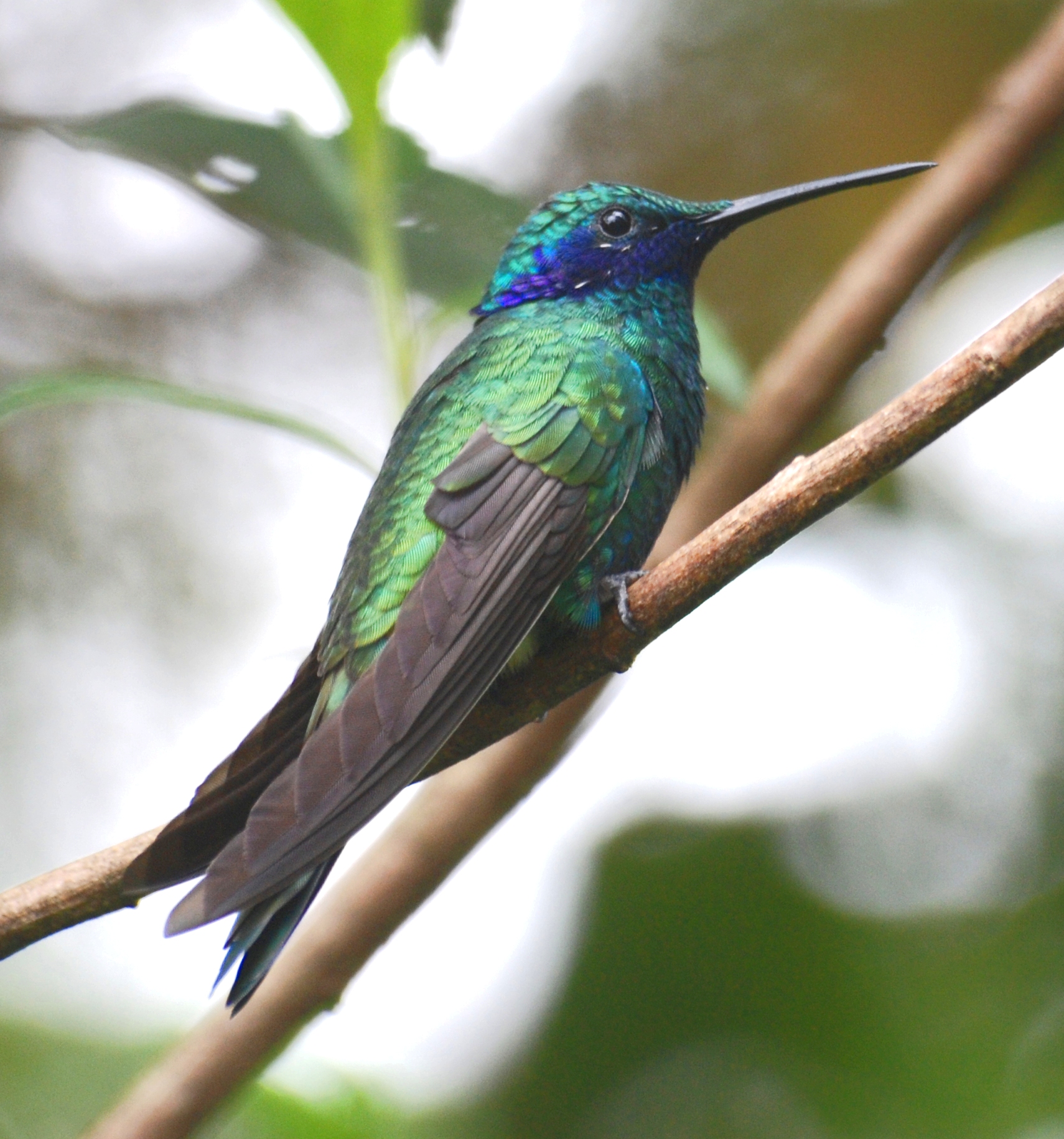
Order:
Apodiformes
Traditionally, the bird order Apodiformes contained three living families: the swifts (Apodidae), the treeswifts (Hemiprocnidae), and the hummingbirds (Trochilidae). In the Sibley-Ahlquist taxonomy, this order is raised to a superorder Apo ...
Family:
Trochilidae
Hummingbirds are birds native to the Americas and comprise the biological family Trochilidae. With about 361 species and 113 genera, they occur from Alaska to Tierra del Fuego, but the vast majority of the species are found in the tropics ar ...
Hummingbird
Hummingbirds are birds native to the Americas and comprise the biological family Trochilidae. With about 361 species and 113 genera, they occur from Alaska to Tierra del Fuego, but the vast majority of the species are found in the tropics ar ...
s are small birds capable of hovering in mid-air due to the rapid flapping of their wings. They are the only birds that can fly backward. Ten species have been recorded in Chile.
*
Sparkling violetear, ''Colibri coruscans''
*
Green-backed firecrown
The green-backed firecrown (''Sephanoides sephaniodes'') is a hummingbird in the "coquettes", tribe Lesbiini of subfamily Lesbiinae. It is found in Argentina, mainland Chile, and the Juan Fernández Islands.HBW and BirdLife International (2020 ...
, ''Sephanoides sephaniodes''
*
Juan Fernandez firecrown
''Juan'' is a given name, the Spanish language, Spanish and Manx language, Manx versions of ''John (given name), John''. It is very common in Spain and in other Spanish-speaking communities around the world and in the Philippines, and also (pronoun ...
, ''Sephanoides fernandensis'' (E)
*
Andean hillstar, ''Oreotrochilus estella''
*
White-sided hillstar, ''Oreotrochilus leucopleurus''
*
Giant hummingbird, ''Patagona gigas''
*
Chilean woodstar, ''Eulidia yarrellii'' (E)
*
Oasis hummingbird
The oasis hummingbird (''Rhodopis vesper'') is a species of hummingbird in tribe Mellisugini of subfamily Trochilinae, the "bee hummingbirds". It is the only species placed in the genus ''Rhodopis''. It is found in Chile and PeruHBW and BirdLi ...
, ''Rhodopis vesper''
*
Peruvian sheartail
The Peruvian sheartail (''Thaumastura cora'') is a species of hummingbird in tribe Mellisugini of subfamily Trochilinae, the "bee hummingbirds". It is the only species placed in the genus ''Thaumastura''. HBW and BirdLife International (2020) ...
, ''Thaumastura cora''
*
Glittering-bellied emerald, ''Chlorostilbon lucidus'' (V)
Limpkin
Order:
GruiformesFamily:
Aramidae
The limpkin is an odd bird that looks like a large
rail, but is skeletally closer to the
cranes
Crane or cranes may refer to:
Common meanings
* Crane (bird), a large, long-necked bird
* Crane (machine), industrial machinery for lifting
** Crane (rail), a crane suited for use on railroads
People and fictional characters
* Crane (surname), ...
. It is found in marshes with some trees or scrub as far north as southern
Florida
Florida is a state located in the Southeastern region of the United States. Florida is bordered to the west by the Gulf of Mexico, to the northwest by Alabama, to the north by Georgia, to the east by the Bahamas and Atlantic Ocean, a ...
.
*
Limpkin, ''Aramus guarauna'' (V)
Rails


Order:
GruiformesFamily:
Rallidae
The rails, or Rallidae, are a large cosmopolitan family of small- to medium-sized, ground-living birds. The family exhibits considerable diversity and includes the crakes, coots, and gallinules. Many species are associated with wetlands, altho ...
Rallidae is a large family of small to medium-sized birds which includes the
rails,
crake
The rails, or Rallidae, are a large cosmopolitan family of small- to medium-sized, ground-living birds. The family exhibits considerable diversity and includes the crakes, coots, and gallinules. Many species are associated with wetlands, althoug ...
s,
coot
Coots are medium-sized water birds that are members of the rail family, Rallidae. They constitute the genus ''Fulica'', the name being the Latin term for "coot". Coots have predominantly black plumage, and—unlike many rails—they are usuall ...
s and
gallinules. Typically they inhabit dense vegetation in damp environments near lakes, swamps, or rivers. In general, they are shy and secretive birds, making them difficult to observe. Most species have strong legs and long toes which are well adapted to soft uneven surfaces. They tend to have short, rounded wings and to be weak fliers. Fourteen species have been recorded in Chile.
*
Austral rail, ''Rallus antarcticus''
*
Purple gallinule Purple gallinule is an alternative name for two species of birds in the rail family. It can refer to:
* Purple swamphen, a group of closely related species of swamphen of the Old World
* American purple gallinule
The purple gallinule (''Porphyr ...
, ''Porphyrio martinica'' (V)
*
Black rail, ''Laterallus jamaicensis''
*
Spotted rail
The spotted rail (''Pardirallus maculatus'') is a species of bird in the subfamily Rallinae of the rail, crake, and coot family Rallidae. It is found in Mexico, Central America, the Caribbean, and South America.HBW and BirdLife International (2 ...
, ''Pardirallus maculatus'' (V)
*
Plumbeous rail
The plumbeous rail (''Pardirallus sanguinolentus'') is a species of bird in the subfamily Rallinae of the rail, crake, and coot family Rallidae. It is found in Argentina, Bolivia, Brazil, Chile, Ecuador, Paraguay, Peru and Uruguay.HBW and BirdL ...
, ''Pardirallus sanguinolentus''
*
Spot-flanked gallinule
The spot-flanked gallinule (''Porphyriops melanops'') is a species of bird in the family Rallidae. It is monotypic in the genus ''Porphyriops''. It is found in Argentina, Bolivia, Brazil, Chile, Colombia, Paraguay, Peru, and Uruguay.
Its natura ...
, ''Porphyriops melanops''
*
Dot-winged crake, ''Porzana spiloptera''
*
Common gallinule, ''Gallinula galeata''
*
Red-fronted coot, ''Fulica rufifrons''
*
Horned coot
The horned coot (''Fulica cornuta'') is a species of bird found in the Andes of South America. It was described by Bonaparte in 1853 based on a specimen collected in Bolivia. For a long time it was known only from the type specimen.
Description ...
, ''Fulica cornuta''
*
Giant coot, ''Fulica gigantea''
*
Red-gartered coot, ''Fulica armillata''
*
Slate-colored coot
The Andean coot (''Fulica ardesiaca''), also known as the slate-colored coot, is a species of bird in subfamily Rallinae of family Rallidae, the rails, gallinules, and coots. It is found in Argentina, Bolivia, Chile, Colombia, Ecuador, and Peru ...
, ''Fulica ardesiaca''
*
White-winged coot, ''Fulica leucoptera''
Plovers

Order:
Charadriiformes
Charadriiformes (, from '' Charadrius'', the type genus of family Charadriidae) is a diverse order of small to medium-large birds. It includes about 390 species and has members in all parts of the world. Most charadriiform birds live near water ...
Family:
Charadriidae
The family Charadriidae includes the
plover
Plovers ( , ) are a widely distributed group of wading birds belonging to the subfamily Charadriinae.
Description
There are about 66 species in the subfamily, most of them called "plover" or " dotterel". The closely related lapwing su ...
s,
dotterels and
lapwing
Lapwings ( subfamily Vanellinae) are any of various ground-nesting birds (family Charadriidae) akin to plovers and dotterels. They range from in length, and are noted for their slow, irregular wingbeats in flight and a shrill, wailing cry. A ...
s. They are small to medium-sized birds with compact bodies, short, thick necks and long, usually pointed, wings. They are found in open country worldwide, mostly in habitats near water. Fourteen species have been recorded in Chile.
*
American golden-plover
The American golden plover (''Pluvialis dominica''), is a medium-sized plover. The genus name is Latin and means relating to rain, from ''pluvia'', "rain". It was believed that golden plovers flocked when rain was imminent. The species name ''d ...
, ''Pluvialis dominica''
*
Black-bellied plover, ''Pluvialis squatarola''
*
Tawny-throated dotterel
The tawny-throated dotterel (''Oreopholus ruficollis'') is a species of bird in the family Charadriidae, the plovers and their relatives. It is found in Argentina, Bolivia, Brazil, Chile, Peru, and Uruguay.
Taxonomy and systematics
The tawny- ...
, ''Oreopholus ruficollis''
*
Southern lapwing, ''Vanellus chilensis''
*
Andean lapwing, ''Vanellus resplendens''
*
Rufous-chested dotterel, ''Charadrius modestus''
*
Killdeer
The killdeer (''Charadrius vociferus'') is a large plover found in the Americas. It was described and given its current scientific name in 1758 by Carl Linnaeus in the 10th edition of his ''Systema Naturae''. Three subspecies are described. Th ...
, ''Charadrius vociferus''
*
Semipalmated plover, ''Charadrius semipalmatus''
*
Wilson's plover, ''Charadrius wilsonia'' (V)
*
Collared plover
The collared plover (''Charadrius collaris'') is a small shorebird in the plover family, Charadriidae. It lives along coasts and riverbanks of the tropical to temperate Americas, from central Mexico south to Chile and Argentina.
This small plove ...
, ''Charadrius collaris''
*
Puna plover
The puna plover (''Charadrius alticola'') is a species of bird in subfamily Charadriinae of family Charadriidae. It is found in Argentina, Bolivia, Chile, and Peru.HBW and BirdLife International (2022) Handbook of the Birds of the World and Bir ...
, ''Charadrius alticola''
*
Two-banded plover
The two-banded plover (''Charadrius falklandicus'') is a species of bird in subfamily Charadriinae of family Charadriidae.HBW and BirdLife International (2022) Handbook of the Birds of the World and BirdLife International digital checklist of ...
, ''Charadrius falklandicus''
*
Snowy plover
The snowy plover (''Charadrius nivosus'') is a small wader in the plover bird family, typically about 5-7" in length. It breeds in the southern and western United States, the Caribbean, Ecuador, Peru, and Chile
Chile, officially the Rep ...
, ''Charadrius nivosus''
*
Diademed sandpiper-plover
The diademed sandpiper-plover or diademed plover (''Phegornis mitchellii'') is a Near Threatened species of bird in subfamily Charadriinae of family Charadriidae. It is found in Argentina, Bolivia, Chile, and Peru.HBW and BirdLife International ...
, ''Phegornis mitchellii''
Oystercatchers

Order:
Charadriiformes
Charadriiformes (, from '' Charadrius'', the type genus of family Charadriidae) is a diverse order of small to medium-large birds. It includes about 390 species and has members in all parts of the world. Most charadriiform birds live near water ...
Family:
Haematopodidae
The
oystercatcher
The oystercatchers are a group of waders forming the family Haematopodidae, which has a single genus, ''Haematopus''. They are found on coasts worldwide apart from the polar regions and some tropical regions of Africa and South East Asia. The e ...
s are large and noisy
plover
Plovers ( , ) are a widely distributed group of wading birds belonging to the subfamily Charadriinae.
Description
There are about 66 species in the subfamily, most of them called "plover" or " dotterel". The closely related lapwing su ...
-like birds, with strong bills used for smashing or prising open
molluscs. Three species have been recorded in Chile.
*
American oystercatcher, ''Haematopus palliatus''
*
Blackish oystercatcher, ''Haematopus ater''
*
Magellanic oystercatcher, ''Haematopus leucopodus''
Avocets and stilts
Order:
Charadriiformes
Charadriiformes (, from '' Charadrius'', the type genus of family Charadriidae) is a diverse order of small to medium-large birds. It includes about 390 species and has members in all parts of the world. Most charadriiform birds live near water ...
Family:
Recurvirostridae
Recurvirostridae is a family of large wading birds, which includes the
avocet
The four species of avocets are a genus, ''Recurvirostra'', of waders in the same avian family as the stilts. The genus name comes from Latin , 'curved backwards' and , 'bill'. The common name is thought to derive from the Italian ( Ferrarese) ...
s and
stilts. The avocets have long legs and long up-curved bills. The stilts have extremely long legs and long, thin, straight bills. Two species have been recorded in Chile.
*
Black-necked stilt
The black-necked stilt (''Himantopus mexicanus'') is a locally abundant shorebird of American wetlands and coastlines. It is found from the coastal areas of California through much of the interior western United States and along the Gulf of Mexic ...
, ''Himantopus mexicanus''
*
Andean avocet, ''Recurvirostra andina''
Thick-knees
Order:
Charadriiformes
Charadriiformes (, from '' Charadrius'', the type genus of family Charadriidae) is a diverse order of small to medium-large birds. It includes about 390 species and has members in all parts of the world. Most charadriiform birds live near water ...
Family:
Burhinidae
The stone-curlews, also known as dikkops or thick-knees, consist of 10 species within the family Burhinidae, and are found throughout the tropical and temperate parts of the world, with two or more species occurring in some areas of Africa, Asia, ...
The thick-knees are a group of largely tropical waders in the family Burhinidae. They are found worldwide within the tropical zone, with some species also breeding in temperate Europe and Australia. They are medium to large waders with strong black or yellow-black bills, large yellow eyes and cryptic plumage. Despite being classed as waders, most species have a preference for arid or semi-arid habitats. One species has been recorded in Chile.
*
Peruvian thick-knee
The Peruvian thick-knee (''Burhinus superciliaris'') is a species of bird in the family Burhinidae. It is found in Chile, Ecuador, and Peru. Its natural habitats are subtropical or tropical dry shrubland, subtropical or tropical seasonally wet or ...
, ''Burhinus superciliaris''
Sheathbills
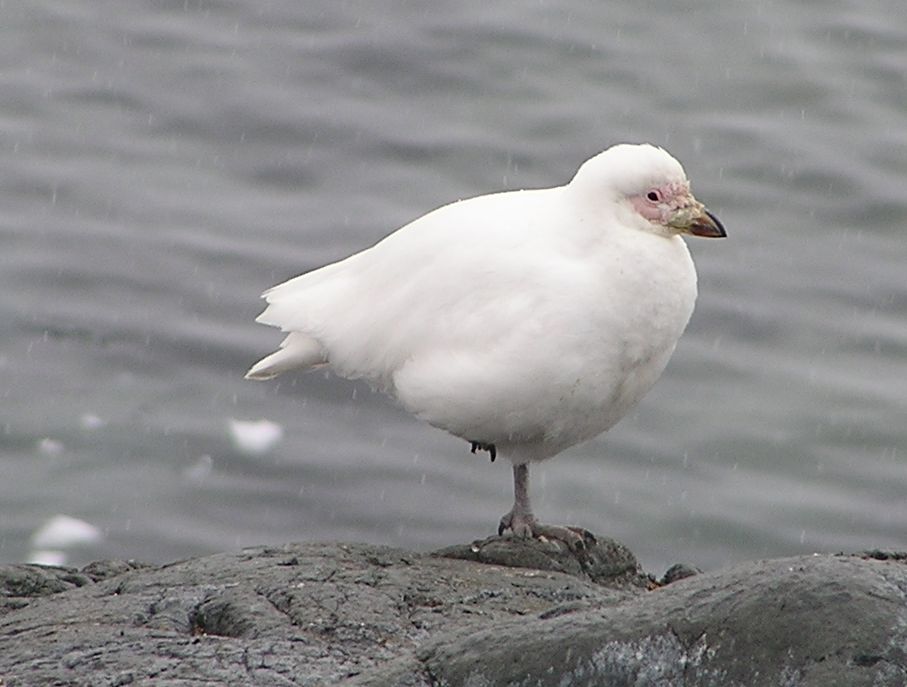
Order:
Charadriiformes
Charadriiformes (, from '' Charadrius'', the type genus of family Charadriidae) is a diverse order of small to medium-large birds. It includes about 390 species and has members in all parts of the world. Most charadriiform birds live near water ...
Family:
Chionidae
The sheathbills are
scavenger
Scavengers are animals that consume dead organisms that have died from causes other than predation or have been killed by other predators. While scavenging generally refers to carnivores feeding on carrion, it is also a herbivorous feeding b ...
s of the Antarctic regions. They have white plumage and look plump and dove-like but are believed to be similar to the ancestors of the modern gulls and terns. One species has been recorded in Chile.
*
Snowy sheathbill
The snowy sheathbill (''Chionis albus''), also known as the greater sheathbill, pale-faced sheathbill, and paddy, is one of two species of sheathbill. It is usually found on the ground. It is the only land bird native to the Antarctic continent. ...
, ''Chionis alba''
Magellanic plover
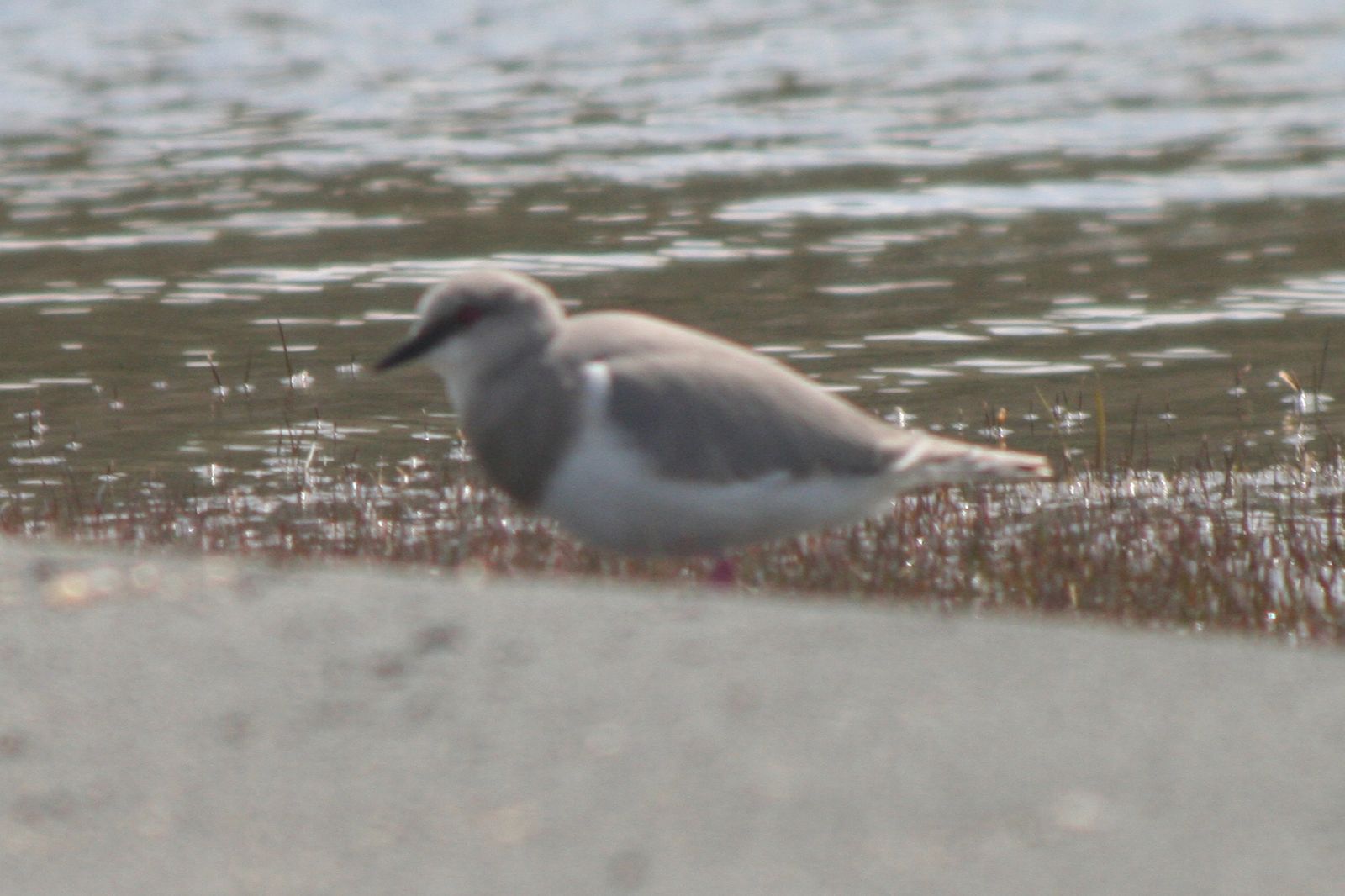
Order:
Charadriiformes
Charadriiformes (, from '' Charadrius'', the type genus of family Charadriidae) is a diverse order of small to medium-large birds. It includes about 390 species and has members in all parts of the world. Most charadriiform birds live near water ...
Family:
Pluvianellidae
The Magellanic plover (''Pluvianellus socialis'') is a rare wader found only in southernmost South America.
Taxonomy
It was long placed in with the other plovers in the family Charadriidae; however, behavioural evidence suggested they were disti ...
The Magellanic plover is a rare wader found only in southernmost South America. In its build and habits it is similar to a
turnstone. Its upperparts and breast are pale gray and the rest of the underparts are white. It has short red legs, a black bill and a red eye. In young birds, the eyes and legs are yellowish.
*
Magellanic plover, ''Pluvianellus socialis''
Sandpipers



Order:
Charadriiformes
Charadriiformes (, from '' Charadrius'', the type genus of family Charadriidae) is a diverse order of small to medium-large birds. It includes about 390 species and has members in all parts of the world. Most charadriiform birds live near water ...
Family:
Scolopacidae
Sandpipers are a large family, Scolopacidae, of waders. They include many species called sandpipers, as well as those called by names such as curlew and snipe. The majority of these species eat small invertebrates picked out of the mud or soil. ...
Scolopacidae is a large diverse family of small to medium-sized shorebirds including the
sandpiper
Sandpipers are a large family, Scolopacidae, of waders. They include many species called sandpipers, as well as those called by names such as curlew and snipe. The majority of these species eat small invertebrates picked out of the mud or soil. ...
s,
curlews,
godwits,
shanks,
tattlers,
woodcock
The woodcocks are a group of seven or eight very similar living species of wading birds in the genus ''Scolopax''. The genus name is Latin for a snipe or woodcock, and until around 1800 was used to refer to a variety of waders. The English name ...
s,
snipe
A snipe is any of about 26 wading bird species in three genera in the family Scolopacidae. They are characterized by a very long, slender bill, eyes placed high on the head, and cryptic/ camouflaging plumage. The '' Gallinago'' snipes have a n ...
s,
dowitchers, and
phalaropes. The majority of these species eat small invertebrates picked out of the mud or soil. Variation in length of legs and bills enables multiple species to feed in the same habitat, particularly on the coast, without direct competition for food. Thirty-two species have been recorded in Chile.
*
Upland sandpiper, ''Bartramia longicauda''
*
Eskimo curlew, ''Numenius borealis'' (extinct)
*
Whimbrel, ''Numenius phaeopus''
*
Bar-tailed godwit, ''Limosa lapponica'' (V)
*
Hudsonian godwit
The Hudsonian godwit (''Limosa haemastica'') is a large shorebird in the sandpiper family, Scolopacidae. The genus name ''Limosa'' is from Latin and means "muddy", from ''limus'', "mud". The specific ''haemastica'' is from Ancient Greek and m ...
, ''Limosa haemastica''
*
Marbled godwit, ''Limosa fedoa'' (V)
*
Ruddy turnstone
The ruddy turnstone (''Arenaria interpres'') is a small cosmopolitan wading bird, one of two species of turnstone in the genus ''Arenaria''.
It is now classified in the sandpiper family Scolopacidae but was formerly sometimes placed in the pl ...
, ''Arenaria interpres''
*
Red knot
The red knot or just knot (''Calidris canutus'') is a medium-sized shorebird which breeds in tundra and the Arctic Cordillera in the far north of Canada, Europe, and Russia. It is a large member of the '' Calidris'' sandpipers, second only to the ...
, ''Calidris canutus''
*
Surfbird, ''Calidris virgata''
*
Stilt sandpiper
The stilt sandpiper (''Calidris himantopus'') is a small shorebird. The scientific name is from Ancient Greek. The genus name ''kalidris'' or ''skalidris'' is a term used by Aristotle for some grey-coloured waterside birds. The specific ''himant ...
, ''Calidris himantopus''
*
Curlew sandpiper
The curlew sandpiper (''Calidris ferruginea'') is a small wader that breeds on the tundra of Arctic Siberia.
It is strongly migratory, wintering mainly in Africa, but also in south and southeast Asia and in Australia and New Zealand. It is a ...
, ''Calidris ferruginea'' (V)
*
Sanderling, ''Calidris alba''
*
Baird's sandpiper, ''Calidris bairdii''
*
Least sandpiper, ''Calidris minutilla''
*
White-rumped sandpiper
The white-rumped sandpiper (''Calidris fuscicollis'') is a small shorebird that breeds in the northern tundra of Canada and Alaska. This bird can be difficult to distinguish from other similar tiny shorebirds; these are known collectively as " ...
, ''Calidris fuscicollis''
*
Buff-breasted sandpiper
The buff-breasted sandpiper (''Calidris subruficollis'') is a small shorebird. The species name ''subruficollis'' is from Latin ''subrufus'', "reddish" (from ''sub'', "somewhat", and ''rufus'', "rufous") and ''collis'', "-necked/-throated" (fro ...
, ''Calidris subruficollis'' (V)
*
Pectoral sandpiper, ''Calidris melanotos''
*
Semipalmated sandpiper
The semipalmated sandpiper (''Calidris pusilla'') is a very small shorebird. The genus name is from Ancient Greek ''kalidris'' or ''skalidris'', a term used by Aristotle for some grey-coloured waterside birds. The specific ''pusilla'' is Latin fo ...
, ''Calidris pusilla''
*
Western sandpiper, ''Calidris mauri''
*
Short-billed dowitcher, ''Limnodromus griseus'' (V)
*
Fuegian snipe, ''Gallinago stricklandii''
*
Magellanic snipe, ''Gallinago magellanica''
*
Puna snipe
The puna snipe (''Gallinago andina'') is a bird in tribe Scolopancinai and subfamily Scolopacinae of family Scolopacidae, the sandpipers and relatives.HBW and BirdLife International (2022) Handbook of the Birds of the World and BirdLife Intern ...
, ''Gallinago andina''
*
Wilson's phalarope, ''Phalaropus tricolor''
*
Red-necked phalarope, ''Phalaropus lobatus'' (V)
*
Red phalarope, ''Phalaropus fulicarius''
*
Spotted sandpiper, ''Actitis macularius''
*
Solitary sandpiper, ''Tringa solitaria'' (V)
*
Wandering tattler
The wandering tattler (''Tringa incana''; formerly ''Heteroscelus incanus'': Pereira & Baker, 2005; Banks ''et al.'', 2006), is a medium-sized wading bird. It is similar in appearance to the closely related gray-tailed tattler, ''T. brevipes''. ...
, ''Tringa incana'' (V)
*
Greater yellowlegs, ''Tringa melanoleuca''
*
Willet
The willet (''Tringa semipalmata'') is a large shorebird in the family Scolopacidae. It is a relatively large and robust sandpiper, and is the largest of the species called "shanks" in the genus '' Tringa''. Its closest relative is the lesser ...
, ''Tringa semipalmata''
*
Lesser yellowlegs, ''Tringa flavipes''
Seedsnipes
Order:
Charadriiformes
Charadriiformes (, from '' Charadrius'', the type genus of family Charadriidae) is a diverse order of small to medium-large birds. It includes about 390 species and has members in all parts of the world. Most charadriiform birds live near water ...
Family:
Thinocoridae
The seedsnipes are a small family of birds that superficially resemble sparrows. They have short legs and long wings and are herbivorous waders. Four species have been recorded in Chile.
*
Rufous-bellied seedsnipe
The rufous-bellied seedsnipe (''Attagis gayi'') is a bird in suborder Scolopaci of order Charadriiformes, the shorebirds. It is found in Argentina, Bolivia, Chile, Ecuador, and Peru.
Taxonomy and systematics
The rufous-bellied seedsnipe sha ...
, ''Attagis gayi''
*
White-bellied seedsnipe
The white-bellied seedsnipe (''Attagis malouinus'') is a species of bird in suborder Scolopaci of order Charadriiformes, the shorebirds. It is found Argentina and Chile.
Taxonomy and systematics
The white-bellied seedsnipe was described by ...
, ''Attagis malouinus''
*
Gray-breasted seedsnipe, ''Thinocorus orbignyianus''
*
Least seedsnipe, ''Thinocorus rumicivorus''
Jacanas
Order:
Charadriiformes
Charadriiformes (, from '' Charadrius'', the type genus of family Charadriidae) is a diverse order of small to medium-large birds. It includes about 390 species and has members in all parts of the world. Most charadriiform birds live near water ...
Family:
Jacanidae
The jacanas (sometimes referred to as Jesus birds or lily trotters) are a group of tropical waders in the family Jacanidae. They are found in the tropical regions around the world. They are noted for their elongated toes and toenails that allow ...
The jacanas are a family of waders found throughout the tropics. They are identifiable by their huge feet and claws which enable them to walk on floating vegetation in the shallow lakes that are their preferred habitat. One species has been recorded in Chile.
*
Wattled jacana
The wattled jacana (''Jacana jacana'') is a wader which is a resident breeder from western Panama and Trinidad south through most of South America east of the Andes.
Breeding
The wattled jacana lays four black-marked brown eggs in a floating n ...
, ''Jacana jacana'' (V)
Painted-snipes
Order:
Charadriiformes
Charadriiformes (, from '' Charadrius'', the type genus of family Charadriidae) is a diverse order of small to medium-large birds. It includes about 390 species and has members in all parts of the world. Most charadriiform birds live near water ...
Family:
Rostratulidae
The Rostratulidae, commonly known as the painted-snipes, are a family of wading birds that consists of two genera: ''Rostratula'' and '' Nycticryphes''.
Description
The painted-snipes are short-legged, long-billed birds similar in shape to the t ...
Painted-snipes are short-legged, long-billed birds similar in shape to the true snipes, but more brightly colored. One species has been recorded in Chile.
*
South American painted-snipe, ''Nycticryphes semicollaris''
Skuas
Order:
Charadriiformes
Charadriiformes (, from '' Charadrius'', the type genus of family Charadriidae) is a diverse order of small to medium-large birds. It includes about 390 species and has members in all parts of the world. Most charadriiform birds live near water ...
Family:
Stercorariidae
The family Stercorariidae are, in general, medium to large birds, typically with gray or brown plumage, often with white markings on the wings. They nest on the ground in temperate and arctic regions and are long-distance migrants. Six species have been recorded in Chile.
*
Chilean skua
The Chilean skua, also called the cinnamon skua (''Stercorarius chilensis''), is a large predatory seabird, which breeds in Argentina and Chile, but ranges as far north as Brazil and Peru when not breeding. A relatively distinctive skua, it has a ...
, ''Stercorarius chilensis''
*
South polar skua
The south polar skua (''Stercorarius maccormicki'') is a large seabird in the skua family, Stercorariidae. An older name for the bird is MacCormick's skua, after explorer and naval surgeon Robert McCormick, who first collected the type speci ...
, ''Stercorarius maccormicki''
*
Brown skua, ''Stercorarius antarctica'' (V)
*
Pomarine jaeger
The pomarine jaeger (''Stercorarius pomarinus''), pomarine skua, or pomatorhine skua, is a seabird in the skua family Stercorariidae. It is a migrant, wintering at sea in the tropical oceans.
Taxonomy
Its relationships are not fully resolved; i ...
, ''Stercorarius pomarinus''
*
Parasitic jaeger
The parasitic jaeger (''Stercorarius parasiticus''), also known as the Arctic skua, Arctic jaeger or parasitic skua, is a seabird in the skua family Stercorariidae. It is a migratory species that breeds in Northern Scandinavia, Scotland, Iceland, ...
, ''Stercorarius parasiticus''
*
Long-tailed jaeger, ''Stercorarius longicaudus''
Skimmers
Order:
Charadriiformes
Charadriiformes (, from '' Charadrius'', the type genus of family Charadriidae) is a diverse order of small to medium-large birds. It includes about 390 species and has members in all parts of the world. Most charadriiform birds live near water ...
Family:
Rynchopidae
The skimmers, forming the genus ''Rynchops'', are tern-like birds in the family Laridae. The genus comprises three species found in South Asia, Africa, and the Americas. They were formerly known as the scissorbills.
The three species are the onl ...
Skimmers are a small family of tropical tern-like birds. They have an elongated lower mandible which they use to feed by flying low over the water surface and skimming the water for small fish. One species has been recorded in Chile.
*
Black skimmer
The black skimmer (''Rynchops niger'') is a tern-like seabird, one of three similar birds species in the skimmer genus ''Rynchops'' in the gull family Laridae. It breeds in North and South America. Northern populations winter in the warmer water ...
, ''Rynchops niger''
Gulls
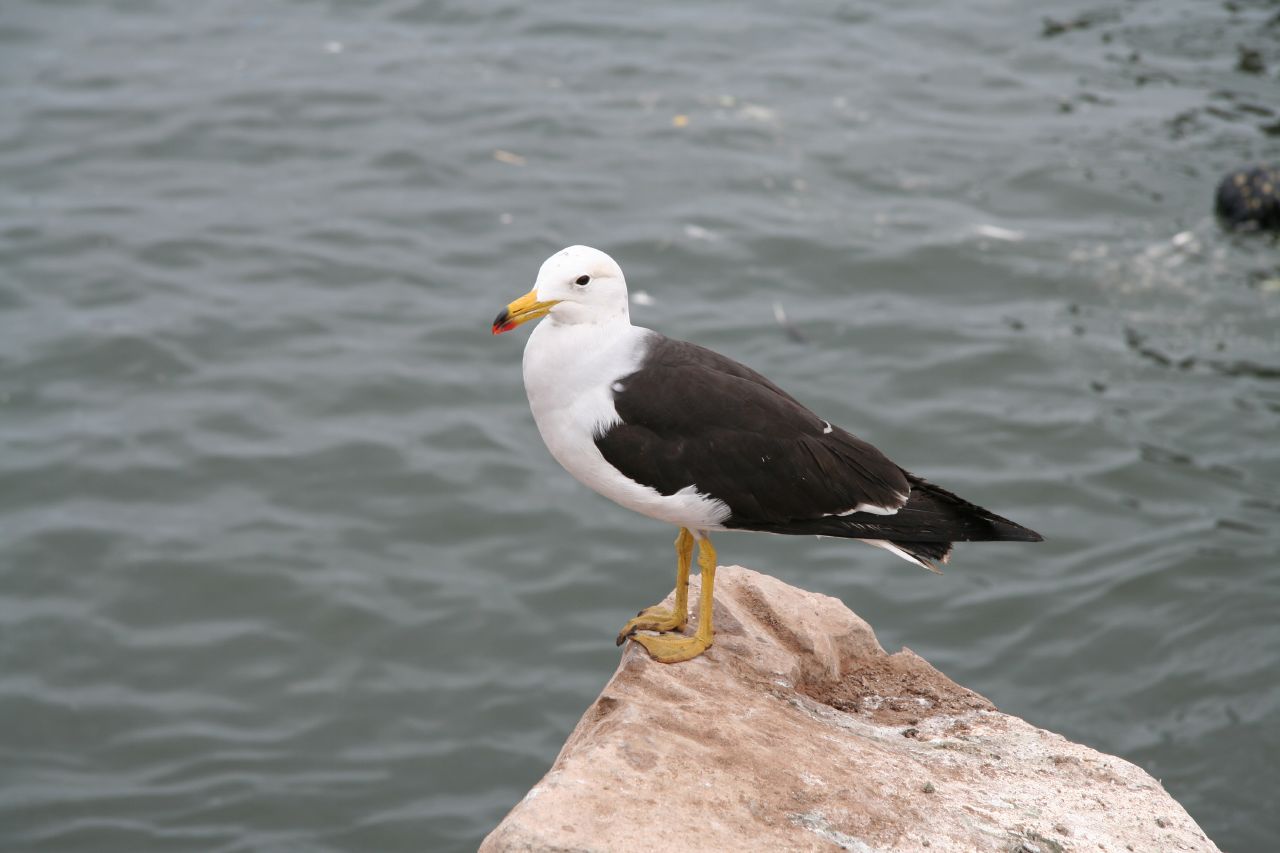
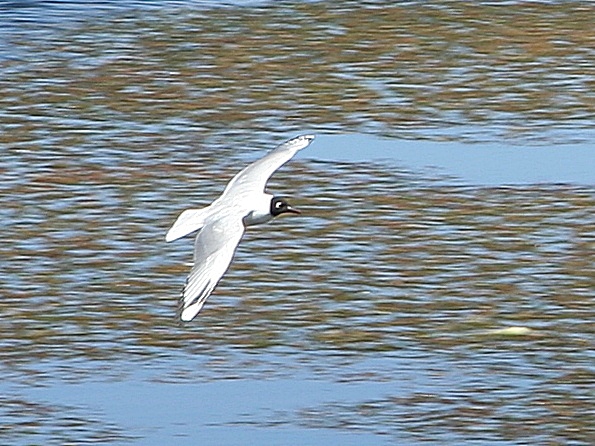

Order:
Charadriiformes
Charadriiformes (, from '' Charadrius'', the type genus of family Charadriidae) is a diverse order of small to medium-large birds. It includes about 390 species and has members in all parts of the world. Most charadriiform birds live near water ...
Family:
Laridae
Laridae is a family of medium to large seabirds and includes
gull
Gulls, or colloquially seagulls, are seabirds of the family Laridae in the suborder Lari. They are most closely related to the terns and skimmers and only distantly related to auks, and even more distantly to waders. Until the 21st century, ...
s,
kittiwakes, and terns. Gulls are typically gray or white, often with black markings on the head or wings. They have longish bills and webbed feet. Terns are a group of generally medium to large seabirds typically with gray or white plumage, often with black markings on the head. Most terns hunt fish by diving but some pick insects off the surface of fresh water. Terns are generally long-lived birds, with several species known to live in excess of 30 years. Thirty-two species of Laridae have been recorded in Chile.
*
Swallow-tailed gull
The swallow-tailed gull (''Creagrus furcatus'') is an equatorial seabird in the gull family, Laridae. It is the only species in the genus ''Creagrus'', which derives from the Latin ''Creagra'' and the Greek ''kreourgos'' which means butcher, al ...
, ''Creagrus furcatus''
*
Sabine's gull
Sabine's gull ( ) (''Xema sabini'') also known as the fork-tailed gull or xeme, is a small gull. It is the only species placed in the genus ''Xema''. It breeds in colonies on coasts and tundra, laying two or three spotted olive-brown eggs in a gr ...
, ''Xema sabini''
*
Bonaparte's gull, ''Chroicocephalus philadelphia'' (V)
*
Andean gull
The Andean gull (''Chroicocephalus serranus'') is a species of gull in the family Laridae. As is the case with many gulls, it has traditionally been placed in the genus '' Larus''.
It is found in the Andes in mountainous regions of Argentina, ...
, ''Chroicocephalus serranus''
*
Brown-hooded gull, ''Chroicocephalus maculipennis''
*
Gray-hooded gull, ''Chroicocephalus cirrocephalus''
*
Dolphin gull, ''Leucophaeus scoresbii''
*
Gray gull, ''Leucophaeus modestus''
*
Laughing gull, ''Leucophaeus atricilla'' (V)
*
Franklin's gull, ''Leucophaeus pipixcan''
*
Belcher's gull
Belcher's gull (''Larus belcheri''), also known as the band-tailed gull, is a bird in the family Laridae found along the Pacific coast of South America. It formerly included the very similar Olrog's gull as a subspecies, but that bird occurs o ...
, ''Larus belcheri''
*
Kelp gull, ''Larus dominicanus''
*
Herring gull Herring gull is a common name for several birds in the genus '' Larus'', all formerly treated as a single species.
Three species are still combined in some taxonomies:
* American herring gull (''Larus smithsonianus'') - North America
* European ...
, ''Larus argentatus'' (V)
*
Brown noddy
The brown noddy or common noddy (''Anous stolidus'') is a seabird in the family Laridae. The largest of the noddies, it can be told from the closely related black noddy by its larger size and plumage, which is dark brown rather than black. The ...
, ''Anous stolidus''
*
Black noddy
The black noddy or white-capped noddy (''Anous minutus'') is a seabird from the family Laridae. It is a medium-sized species of tern with black plumage and a white cap. It closely resembles the lesser noddy (''Anous tenuirostris'') with which it ...
, ''Anous minutus''
*
Gray noddy
The grey noddy or grey ternlet (''Anous albivitta'') is a seabird belonging to the family Laridae. It was once regarded as a pale morph of the blue noddy (''Anous cerulea'') but is now usually considered to be a separate species.
Taxonomy
The ...
, ''Anous albivitta''
*
Sooty tern
The sooty tern (''Onychoprion fuscatus'') is a seabird in the family Laridae. It is a bird of the tropical oceans, returning to land only to breed on islands throughout the equatorial zone.
Taxonomy
The sooty tern was described by Carl Linna ...
, ''Onychoprion fuscatus''
*
Bridled tern, ''Onychoprion anaethetus'' (V)
*
Least tern, ''Sternula antillarum'' (V)
*
Peruvian tern
The Peruvian tern (''Sternula lorata'') is a species of tern in the family Laridae.
Found in northern Chile, Ecuador, and Peru, its natural habitats are hot deserts, sandy shores, and coastal saline lagoons. It is threatened by habitat loss.
In ...
, ''Sternula lorata''
*
Large-billed tern, ''Phaetusa simplex'' (H)
*
Gull-billed tern, ''Gelochelidon nilotica'' (V)
*
Inca tern
The Inca tern (''Larosterna inca'') is a tern in the family Laridae. It is the only member of the genus ''Larosterna''.
This uniquely plumaged bird breeds on the coasts of Peru and Chile, and is restricted to the Humboldt Current. In 2021 a ...
, ''Larosterna inca''
*
Black tern, ''Chlidonias niger'' (V)
*
Common tern
The common tern (''Sterna hirundo'') is a seabird in the family Laridae. This bird has a circumpolar distribution, its four subspecies breeding in temperate and subarctic regions of Europe, Asia and North America. It is strongly migrat ...
, ''Sterna hirundo''
*
Arctic tern
The Arctic tern (''Sterna paradisaea'') is a tern in the family Laridae. This bird has a circumpolar breeding distribution covering the Arctic and sub-Arctic regions of Europe (as far south as Brittany), Asia, and North America (as far ...
, ''Sterna paradisaea''
*
South American tern, ''Sterna hirundinacea''
*
Antarctic tern, ''Sterna vittata'' (H)
*
Snowy-crowned tern, ''Sterna trudeaui''
*
Elegant tern, ''Thalasseus elegans''
*
Sandwich tern, ''Thalasseus sandvicensis''
*
Royal tern, ''Thalasseus maximus'' (V)
Tropicbirds

Order:
PhaethontiformesFamily:
Phaethontidae
Tropicbirds are a family, Phaethontidae, of tropical pelagic seabirds. They are the sole living representatives of the order Phaethontiformes. For many years they were considered part of the Pelecaniformes, but genetics indicates they are most ...
Tropicbird
Tropicbirds are a family, Phaethontidae, of tropical pelagic seabirds. They are the sole living representatives of the order Phaethontiformes. For many years they were considered part of the Pelecaniformes, but genetics indicates they are most ...
s are slender white birds of tropical oceans, with exceptionally long central tail feathers. Their heads and long wings have black markings. Three species have been recorded in Chile.
*
Red-billed tropicbird
The red-billed tropicbird (''Phaethon aethereus'') is a tropicbird, one of three closely related species of seabird of tropical oceans. Superficially resembling a tern in appearance, it has mostly white plumage with some black markings on the w ...
, ''Phaethon aethereus''
*
Red-tailed tropicbird
The red-tailed tropicbird (''Phaethon rubricauda'') is a seabird native to tropical parts of the Indian and Pacific Oceans. One of three closely related species of tropicbird (Phaethontidae), it was described by Pieter Boddaert in 1783. Supe ...
, ''Phaethon rubricauda''
*
White-tailed tropicbird
The white-tailed tropicbird (''Phaethon lepturus'') is a tropicbird. It is the smallest of three closely related seabirds of the tropical oceans and smallest member of the order Phaethontiformes. It is found in the tropical Atlantic, western ...
, ''Phaethon lepturus''
Penguins

Order:
SphenisciformesFamily:
Spheniscidae
The penguins are a group of aquatic, flightless birds living almost exclusively in the Southern Hemisphere. Most penguins feed on
krill
Krill are small crustaceans of the order Euphausiacea, and are found in all the world's oceans. The name "krill" comes from the Norwegian word ', meaning "small fry of fish", which is also often attributed to species of fish.
Krill are consid ...
,
fish
Fish are aquatic, craniate, gill-bearing animals that lack limbs with digits. Included in this definition are the living hagfish, lampreys, and cartilaginous and bony fish as well as various extinct related groups. Approximately 95% ...
,
squid
True squid are molluscs with an elongated soft body, large eyes, eight arms, and two tentacles in the superorder Decapodiformes, though many other molluscs within the broader Neocoleoidea are also called squid despite not strictly fitting ...
and other forms of sealife caught while swimming underwater. Nine species have been recorded in Chile.
*
King penguin
The king penguin (''Aptenodytes patagonicus'') is the second largest species of penguin, smaller, but somewhat similar in appearance to the emperor penguin. There are two subspecies: ''A. p. patagonicus'' and ''A. p. halli''; ''patagonicus'' i ...
, ''Aptenodytes patagonicus''
*
Emperor penguin
The emperor penguin (''Aptenodytes forsteri'') is the tallest and heaviest of all living penguin species and is endemic to Antarctica. The male and female are similar in plumage and size, reaching in length and weighing from . Feathers of ...
, ''Aptenodytes forsteri'' (V)
*
Gentoo penguin
The gentoo penguin ( ) (''Pygoscelis papua'') is a penguin species (or possibly a species complex) in the genus '' Pygoscelis'', most closely related to the Adélie penguin (''P. adeliae'') and the chinstrap penguin (''P. antarcticus''). The ea ...
, ''Pygoscelis papua''
*
Chinstrap penguin, ''Pygoscelis antarctica'' (V)
*
Little penguin
The little penguin (''Eudyptula minor'') is a species of penguin from New Zealand. They are commonly known as little blue penguins or blue penguins owing to their slate-blue plumage and are also known by their Māori name .
The Australian l ...
, ''Eudyptula minor'' (V)
*
Humboldt penguin
The Humboldt penguin (''Spheniscus humboldti'') is a medium-sized penguin. It resides in South America, its range mainly contains most of coastal Peru. Its nearest relatives are the African penguin, the Magellanic penguin and the Galápagos p ...
, ''Spheniscus humboldti''
*
Magellanic penguin
The Magellanic penguin (''Spheniscus magellanicus'') is a South American penguin, breeding in coastal Patagonia, including Argentina, Chile, and the Falkland Islands, with some migrating to Brazil and Uruguay, where they are occasionally see ...
, ''Spheniscus magellanicus''
*
Macaroni penguin
The macaroni penguin (''Eudyptes chrysolophus'') is a species of penguin found from the Subantarctic to the Antarctic Peninsula. One of six species of crested penguin, it is very closely related to the royal penguin, and some authorities consid ...
, ''Eudyptes chrysolophus''
*
Rockhopper penguin
The rockhopper penguins are three closely related taxa of crested penguins that have been traditionally treated as a single species and are sometimes split into three species.
Not all experts agree on the classification of these penguins. Some ...
, ''Eudyptes chrysocome''
Albatrosses
Order:
Procellariiformes
Procellariiformes is an order of seabirds that comprises four families: the albatrosses, the petrels and shearwaters, and two families of storm petrels. Formerly called Tubinares and still called tubenoses in English, procellariiforms are of ...
Family:
Diomedeidae
Albatrosses, of the biological family Diomedeidae, are large seabirds related to the procellariids, storm petrels, and diving petrels in the order Procellariiformes (the tubenoses). They range widely in the Southern Ocean and the North Pac ...
The albatrosses are among the largest of flying birds, and the great albatrosses from the genus ''Diomedea'' have the largest wingspans of any extant birds. Eleven species have been recorded in Chile.
*
Waved albatross, ''Phoebastria irrorata'' (V)
*Royal albatross, ''
Diomedea epomophora
The southern royal albatross or toroa, (''Diomedea epomophora'') is a large seabird from the albatross family. At an average wingspan of above , it is one of the two largest species of albatross, together with the wandering albatross. Recent st ...
''
*
Wandering albatross
The wandering albatross, snowy albatross, white-winged albatross or goonie (''Diomedea exulans'') is a large seabird from the family Diomedeidae, which has a circumpolar range in the Southern Ocean. It was the last species of albatross to be de ...
, ''Diomedea exulans''
*
Sooty albatross, ''Phoebetria fusca'' (V)
*
Light-mantled albatross
The light-mantled albatross (''Phoebetria palpebrata'') also known as the grey-mantled albatross or the light-mantled sooty albatross, is a small albatross in the genus '' Phoebetria'', which it shares with the sooty albatross. The light-mantled ...
, ''Phoebetria palpebrata''
*
Black-browed albatross
The black-browed albatross (''Thalassarche melanophris''), also known as the black-browed mollymawk,Robertson, C. J. R. (2003) is a large seabird of the albatross family Diomedeidae; it is the most widespread and common member of its family.
...
, ''Thalassarche melanophris''
*
Gray-headed albatross
The grey-headed albatross (''Thalassarche chrysostoma'') also known as the gray-headed mollymawk, is a large seabird from the albatross family. It has a circumpolar distribution, nesting on isolated islands in the Southern Ocean and feeding at hi ...
, ''Thalassarche chrysostoma''
*
Buller's albatross
Buller's albatross (''Thalassarche bulleri'') or Buller's mollymawk, is a small mollymawk in the albatross family.
It breeds on islands around New Zealand, and feeds in the seas off Australia and the South Pacific.
Taxonomy
Mollymawks are a ...
, ''Thalassarche bulleri''
*
White-capped albatross (also called shy albatross), ''Thalassarche cauta'' (V)
*
Salvin's albatross, ''Thalassarche salvini''
*
Chatham albatross, ''Thalassarche eremita''
Southern storm-petrels
Order:
Procellariiformes
Procellariiformes is an order of seabirds that comprises four families: the albatrosses, the petrels and shearwaters, and two families of storm petrels. Formerly called Tubinares and still called tubenoses in English, procellariiforms are of ...
Family:
Oceanitidae
The storm-petrels are the smallest seabirds, relatives of the
petrel
Petrels are tube-nosed seabirds in the bird order Procellariiformes.
Description
The common name does not indicate relationship beyond that point, as "petrels" occur in three of the four families within that group (all except the albatross ...
s, feeding on
plankton
Plankton are the diverse collection of organisms found in water (or air) that are unable to propel themselves against a current (or wind). The individual organisms constituting plankton are called plankters. In the ocean, they provide a cr ...
ic crustaceans and small fish picked from the surface, typically while hovering. The flight is fluttering and sometimes
bat-like. Until 2018, this family's species were included with the other storm-petrels in family Hydrobatidae. Seven species have been recorded in Chile.
*
White-bellied storm-petrel, ''Fregetta grallaria''
*
Black-bellied storm-petrel
The black-bellied storm petrel (''Fregetta tropica'') is a species of seabird in the family Oceanitidae.
It is found in Antarctica, Argentina, Australia, Bouvet Island, Brazil, Chile, Falkland Islands, French Polynesia, French Southern Territo ...
, ''Fregetta tropica'' (V)
*
Wilson's storm-petrel
Wilson's storm petrel (''Oceanites oceanicus''), also known as Wilson's petrel, is a small seabird of the austral storm petrel family Oceanitidae. It is one of the most abundant bird species in the world and has a circumpolar distribution main ...
, ''Oceanites oceanicus''
*
Pincoya storm-petrel, ''Oceanites pincoyae''
*
Elliot's storm-petrel
Elliot's storm petrel (''Oceanites gracilis'') is a species of seabird in the storm petrel family storm-petrel, Hydrobatidae. The species is also known as the white-vented storm petrel. , ''Oceanites gracilis''
*
Gray-backed storm-petrel
The grey-backed storm petrel (''Garrodia nereis'') is a species of seabird in the austral storm petrel family Oceanitidae. It is monotypic within the genus ''Garrodia''. It is found in Antarctica, Argentina, Australia, Chile, Falkland Islands, Fr ...
, ''Garrodia nereis'' (V)
*
White-faced storm-petrel, ''Pelagodroma marina''
Northern storm-petrels
Order:
Procellariiformes
Procellariiformes is an order of seabirds that comprises four families: the albatrosses, the petrels and shearwaters, and two families of storm petrels. Formerly called Tubinares and still called tubenoses in English, procellariiforms are of ...
Family:
Hydrobatidae
Though the members of this family are similar in many respects to the southern storm-petrels, including their general appearance and habits, there are enough genetic differences to warrant their placement in a separate family. Three species have been recorded in Chile.
*
Wedge-rumped storm-petrel
The wedge-rumped storm petrel (''Hydrobates tethys'') is a storm petrel. It breeds in the Galápagos Islands and on the coast of Peru. It was formerly defined in the genus ''Oceanodroma'' before that genus was synonymized with ''Northern storm pe ...
, ''Hydrobates tethys''
*
Markham's storm-petrel
Markham's storm petrel (''Hydrobates markhami'') is a species of storm petrel in the family Hydrobatidae. An all-black to sooty brown seabird, Markham's storm petrel is difficult to differentiate from the black petrel ''Procellaria parkinsoni'' ...
, ''Hydrobates markhami''
*
Hornby's storm-petrel
The ringed storm petrel (''Hydrobates hornbyi''), also known as Hornby's storm petrel, is a seabird that ranges in the Humboldt Current off the coasts of South America. The species is a very distinctive member of the storm petrel family, with ...
, ''Hydrobates hornbyi''
Shearwaters
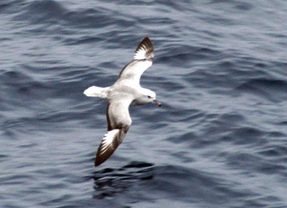
Order:
Procellariiformes
Procellariiformes is an order of seabirds that comprises four families: the albatrosses, the petrels and shearwaters, and two families of storm petrels. Formerly called Tubinares and still called tubenoses in English, procellariiforms are of ...
Family:
Procellariidae
The family Procellariidae is a group of seabirds that comprises the fulmarine petrels, the gadfly petrels, the diving petrels, the prions, and the shearwaters. This family is part of the bird order Procellariiformes (or tubenoses), which also ...
The procellariids are the main group of medium-sized "true petrels", characterized by united nostrils with medium septum and a long outer functional primary. Thirty-seven species have been recorded in Chile.
*
Southern giant-petrel, ''Macronectes giganteus''
*
Northern giant-petrel, ''Macronectes halli''
*
Northern fulmar
The northern fulmar (''Fulmarus glacialis''), fulmar, or Arctic fulmar is a highly abundant seabird found primarily in subarctic regions of the North Atlantic and North Pacific oceans. There has been one confirmed sighting in the Southern Hem ...
, ''Fulmarus glacialis'' (V)
*
Southern fulmar
The southern fulmar (''Fulmarus glacialoides'') is a seabird of the Southern Hemisphere. Along with the northern fulmar, ''F. glacialis'', it belongs to the fulmar genus ''Fulmarus'' in the family Procellariidae, the true petrels. It is also ...
, ''Fulmarus glacialoides''
*
Antarctic petrel
The Antarctic petrel (''Thalassoica antarctica'') is a boldly marked dark brown and white petrel, found in Antarctica, most commonly in the Ross and Weddell Seas. They eat Antarctic krill, fish, and small squid. They feed while swimming but ca ...
, ''Thalassoica antarctica'' (V)
*
Cape petrel, ''Daption capense''
*
Kerguelen petrel, ''Aphrodroma brevirostris'' (V)
*
Gould's petrel
Gould's petrel (''Pterodroma leucoptera'') is a species of seabird in the family Procellariidae. The common name commemorates the English ornithologist and bird artist John Gould (1804–1881).
Description
Gould's petrel is a small gadfly petr ...
, ''Pterodroma leucoptera'' (V)
*
Great-winged petrel, ''Pterodroma macroptera'' (V)
*
Soft-plumaged petrel, ''Pterodroma mollis'' (V)
*
White-headed petrel, ''Pterodroma lessonii'' (H)
*
Cook's petrel
Cook's petrel (''Pterodroma cookii'') or the blue-footed petrel, is a Procellariform seabird. It is a member of the gadfly petrels and part of the subgroup known as Cookilaria petrels, which includes the very similar Stejneger's petrel.
Morphol ...
, ''Pterodroma cookii'' (V)
*
Black-winged petrel, ''Pterodroma nigripennis'' (V)
*
Masatierra petrel, ''Pterodroma defilippiana''
*
Stejneger's petrel
Stejneger's petrel (''Pterodroma longirostris'') is a species of seabird and a member of the gadfly petrels. The bird is 26–31 cm in size, with a 53–66 cm wingspan.
This species is highly pelagic, rarely approaching land, except t ...
, ''Pterodroma longirostris''
*
Murphy's petrel, ''Pterodroma ultima'' (V)
*
Kermadec petrel, ''Pterodroma neglecta''
*
Mottled petrel, ''Pterodroma inexpectata'' (H)
*
Juan Fernández petrel
The Juan Fernández petrel (''Pterodroma externa'') is a species of seabird in the family Procellariidae. It nests on a single island off the coast of Chile, in the Juan Fernández Archipelago. It was previously classified as a subspecies of the ...
, ''Pterodroma externa''
*
Blue petrel
The blue petrel (''Halobaena caerulea'') is a small seabird in the shearwater and petrel family, Procellariidae. This small petrel is the only member of the genus ''Halobaena'', but is closely allied to the prions. It is distributed across the So ...
, ''Halobaena caerulea''
*
Broad-billed prion
The broad-billed prion (''Pachyptila vittata'') is a small pelagic seabird in the shearwater and petrel family, Procellariidae. It is the largest prion, with grey upperparts plumage, and white underparts. The sexes are alike. It ranges from the s ...
, ''Pachyptila vittata'' (V)
*
Antarctic prion
The Antarctic prion (''Pachyptila desolata'') also known as the dove prion, or totorore in Māori, is the largest of the prions, a genus of small petrels of the Southern Ocean.
Taxonomy
The Antarctic prion was formally described in 1789 by th ...
, ''Pachyptila desolata''
*
Slender-billed prion, ''Pachyptila belcheri''
*
Gray petrel
The grey petrel (''Procellaria cinerea''), also called the brown petrel, pediunker or grey shearwater is a species of seabird in the Procellariidae, or petrel family. It is pelagic and occurs in the open seas of the Southern Hemisphere, mainly b ...
, ''Procellaria cinerea'' (V)
*
White-chinned petrel
The white-chinned petrel (''Procellaria aequinoctialis'') also known as the Cape hen and shoemaker, is a large shearwater in the family Procellariidae. It ranges around the Southern Ocean as far north as southern Australia, Peru and Namibia, ...
, ''Procellaria aequinoctialis''
*
Parkinson's petrel
The black petrel (''Procellaria parkinsoni''), also called the Parkinson's petrel, is a medium-sized, black-plumaged petrel, the smallest of the ''Procellaria''. The species is an endemic breeder of New Zealand, breeding only on Great Barrier Is ...
, ''Procellaria parkinsoni''
*
Westland petrel
The Westland petrel (''Procellaria westlandica''), (Māori: ''tāiko''), also known as the Westland black petrel, is a moderately large seabird in the petrel family Procellariidae, that is endemic to New Zealand. Described by Robert Falla in 194 ...
, ''Procellaria westlandica''
*
Buller's shearwater
Buller's shearwater (''Ardenna bulleri'') is a Pacific species of seabird in the family Procellariidae; it is also known as the grey-backed shearwater or New Zealand shearwater. A member of the black-billed wedge-tailed ''Thyellodroma'' gro ...
, ''Ardenna bulleri''
*
Sooty shearwater
The sooty shearwater (''Ardenna grisea'') is a medium-large shearwater in the seabird family Procellariidae. In New Zealand, it is also known by its Māori name , and as muttonbird, like its relatives the wedge-tailed shearwater (''A. pacif ...
, ''Ardenna griseus''
*
Great shearwater, ''Ardenna gravis''
*
Pink-footed shearwater
The pink-footed shearwater (''Ardenna creatopus'') is a species of seabird. The bird is in length, with a wingspan. It is polymorphic, having both darker- and lighter-phase populations. Together with the equally light-billed flesh-footed shea ...
, ''Ardenna creatopus''
*
Flesh-footed shearwater, ''Ardenna carneipes'' (V)
*
Manx shearwater
The Manx shearwater (''Puffinus puffinus'') is a medium-sized shearwater in the seabird family Procellariidae. The scientific name of this species records a name shift: Manx shearwaters were called Manks puffins in the 17th century. Puffin is an ...
, ''Puffinus puffinus''
*
Little shearwater
The little shearwater (''Puffinus assimilis'') is a small shearwater in the petrel family Procellariidae. Despite the generic name, it is unrelated to the puffins, which are auks, the only similarity being that they are both burrow-nesting ...
, ''Puffinus elegans''
*
Peruvian diving-petrel, ''Pelecanoides garnotii''
*
Common diving-petrel
The common diving petrel (''Pelecanoides urinatrix''), also known as the smaller diving petrel or simply the diving petrel, is a diving petrel, one of four very similar auk-like small petrels of the southern oceans. It is native to South Atlanti ...
, ''Pelecanoides urinatrix''
*
Magellanic diving-petrel
The Magellanic diving-petrel (''Pelecanoides magellani'') is a species of diving petrel, one of five very similar, small, auk-like petrels found exclusively in the southern oceans. It is one of the smaller species of diving-petrels, though size ...
, ''Pelecanoides magellani''
Storks
Order:
Ciconiiformes
Storks are large, long-legged, long-necked wading birds with long, stout bills. They belong to the family called Ciconiidae, and make up the order Ciconiiformes . Ciconiiformes previously included a number of other families, such as herons an ...
Family:
Ciconiidae
Storks are large, long-legged, long-necked, wading birds with long, stout bills. Storks are mute, but bill-clattering is an important mode of communication at the nest. Their nests can be large and may be reused for many years. Many species are migratory. Two species have been recorded in Chile.
*
Maguari stork, ''Ciconia maguari'' (V)
*
Wood stork
The wood stork (''Mycteria americana'') is a large American wading bird in the family Ciconiidae ( storks), the only member of the family to breed in North America. It was formerly called the "wood ibis", though it is not an ibis. It is foun ...
, ''Mycteria americana'' (V)
Frigatebirds
Order:
SuliformesFamily:
Fregatidae
Frigatebirds are a family of seabirds called Fregatidae which are found across all tropical and subtropical oceans. The five extant species are classified in a single genus, ''Fregata''. All have predominantly black plumage, long, deeply forked ...
Frigatebird
Frigatebirds are a family of seabirds called Fregatidae which are found across all tropical and subtropical oceans. The five extant species are classified in a single genus, ''Fregata''. All have predominantly black plumage, long, deeply forke ...
s are large seabirds usually found over tropical oceans. They are large, black-and-white or completely black, with long wings and deeply forked tails. The males have colored inflatable throat pouches. They do not swim or walk and cannot take off from a flat surface. Having the largest wingspan-to-body-weight ratio of any bird, they are essentially aerial, able to stay aloft for more than a week. Two species have been recorded in Chile.
*
Magnificent frigatebird
The magnificent frigatebird (''Fregata magnificens'') is a seabird of the frigatebird family Fregatidae. With a length of and wingspan of it is the largest species of frigatebird. It occurs over tropical and subtropical waters off America, bet ...
, ''Fregata magnificens'' (V)
*
Great frigatebird
The great frigatebird (''Fregata minor'') is a large seabird in the frigatebird family. There are major nesting populations in the tropical Pacific (including the Galapagos Islands) and Indian Oceans, as well as a tiny population in the South ...
, ''Fregata minor''
Boobies
Order:
SuliformesFamily:
Sulidae
The bird family Sulidae comprises the gannets and boobies. Collectively called sulids, they are medium-large coastal seabirds that plunge-dive for fish and similar prey. The 10 species in this family are often considered congeneric in older s ...
The sulids comprise the
gannet
Gannets are seabirds comprising the genus ''Morus'' in the family Sulidae, closely related to boobies.
Gannets are large white birds with yellowish heads; black-tipped wings; and long bills. Northern gannets are the largest seabirds in the ...
s and
boobies. Both groups are medium to large coastal seabirds that plunge-dive for fish. Six species have been recorded in Chile.
*
Blue-footed booby
The blue-footed booby (''Sula nebouxii'') is a marine bird native to subtropical and tropical regions of the eastern Pacific Ocean. It is one of six species of the genus ''Sula'' – known as boobies. It is easily recognizable by its distincti ...
, ''Sula nebouxii''
*
Peruvian booby, ''Sula variegata''
*
Masked booby
The masked booby (''Sula dactylatra''), also called the masked gannet or the blue-faced booby, is a large seabird of the booby and gannet family, Sulidae. First described by the French naturalist René-Primevère Lesson in 1831, the masked boob ...
, ''Sula dactylatra''
*
Nazca booby
The Nazca booby (''Sula granti'') is a large seabird of the booby family, Sulidae, native to the eastern Pacific. First described by Walter Rothschild in 1902, it was long considered a subspecies of the masked booby until recognised as distinct g ...
, ''Sula granti'' (V)
*
Red-footed booby
The red-footed booby (''Sula sula'') is a large seabird of the booby family, Sulidae. Adults always have red feet, but the colour of the plumage varies. They are powerful and agile fliers, but they are clumsy in takeoffs and landings. They are ...
, ''Sula sula'' (V)
*
Brown booby
The brown booby (''Sula leucogaster'') is a large seabird of the booby family Sulidae, of which it is perhaps the most common and widespread species. It has a pantropical range, which overlaps with that of other booby species. The gregarious b ...
, ''Sula leucogaster'' (V)
Cormorants
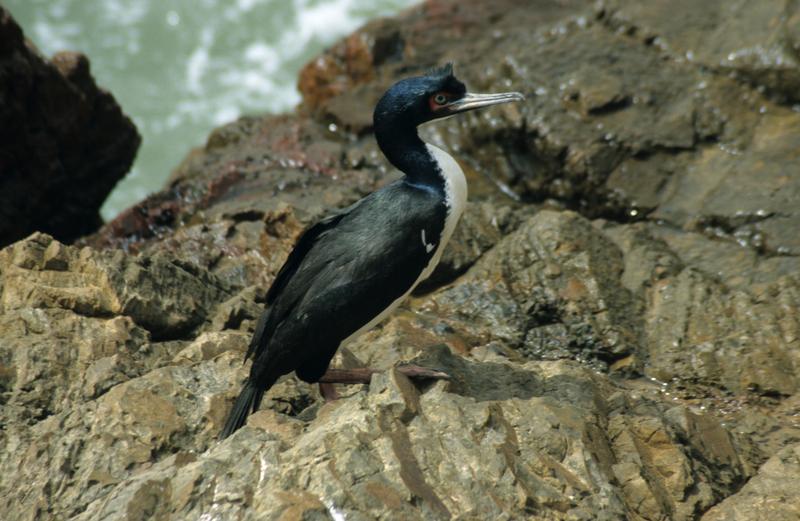
Order:
SuliformesFamily:
Phalacrocoracidae
Phalacrocoracidae is a family of approximately 40 species of aquatic birds commonly known as cormorants and shags. Several different classifications of the family have been proposed, but in 2021 the IOC adopted a consensus taxonomy of seven gen ...
Phalacrocoracidae is a family of medium to large coastal, fish-eating seabirds that includes cormorants and shags. Plumage coloration varies, with the majority having mainly dark plumage, some species being black-and-white and a few being colorful. Five species have been recorded in Chile.
*
Red-legged cormorant, ''Phalacrocorax gaimardi''
*
Neotropic cormorant, ''Phalacrocorax brasilianus''
*
Magellanic cormorant, ''Phalacrocorax magellanicus''
*
Guanay cormorant
The Guanay cormorant or Guanay shag (''Leucocarbo bougainvilliorum'') is a member of the cormorant family found on the Pacific coast of Peru and northern Chile. (The Argentinian population on the Patagonian Atlantic coast appears to be ex ...
, ''Phalacrocorax bougainvillii''
*
Imperial cormorant
The imperial shag or imperial cormorant (''Leucocarbo atriceps'') is a black and white cormorant native to southern South America, primarily in rocky coastal regions, but locally also at large inland lakes. Some taxonomic authorities, including ...
(shag), ''Phalacrocorax atriceps''
Pelicans

Order:
Pelecaniformes
The Pelecaniformes are an order of medium-sized and large waterbirds found worldwide. As traditionally—but erroneously—defined, they encompass all birds that have feet with all four toes webbed. Hence, they were formerly also known by such n ...
Family:
Pelecanidae
The Pelecanidae is a family of pelecaniform birds within the Pelecani that contains two genera: the extinct ''Eopelecanus'' and the extant '' Pelecanus''. The family was monotypic until the description of ''Eopelecanus'' in 2021.
Pelecanids hav ...
Pelican
Pelicans (genus ''Pelecanus'') are a genus of large water birds that make up the family Pelecanidae. They are characterized by a long beak and a large throat pouch used for catching prey and draining water from the scooped-up contents before ...
s are large water birds with a distinctive pouch under their beak. As with other members of the order Pelecaniformes, they have webbed feet with four toes. Two species have been recorded in Chile.
*
Brown pelican
The brown pelican (''Pelecanus occidentalis'') is a bird of the pelican family, Pelecanidae, one of three species found in the Americas and one of two that feed by diving into water. It is found on the Atlantic Coast from New Jersey to the mo ...
, ''Pelecanus occidentalis'' (V)
*
Peruvian pelican
The Peruvian pelican (''Pelecanus thagus'') is a member of the pelican family. It lives on the west coast of South America, breeding in loose colonies from about 33.5° in central Chile to Piura in northern Peru, and occurring as a visitor i ...
, ''Pelecanus thagus''
Herons
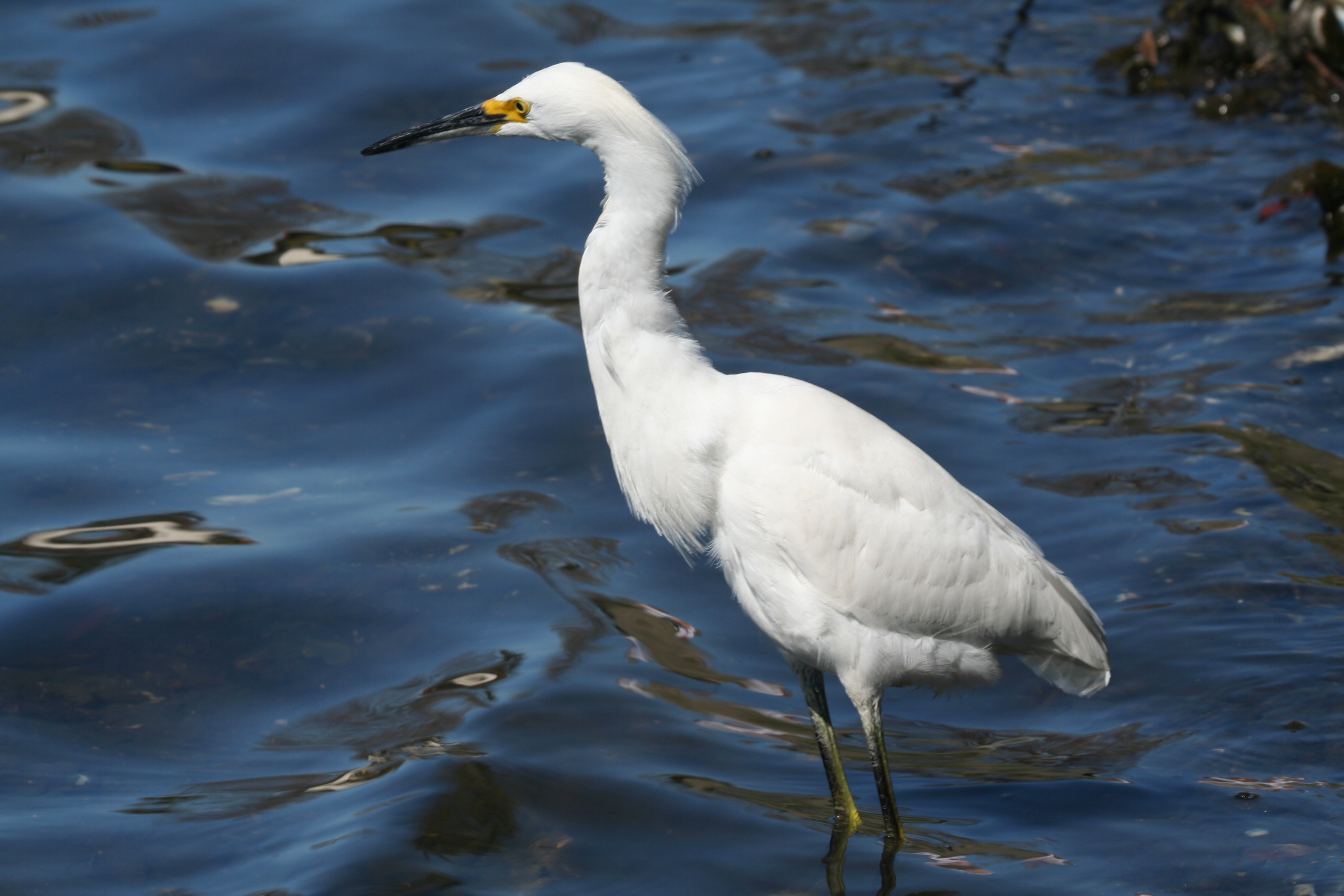
Order:
Pelecaniformes
The Pelecaniformes are an order of medium-sized and large waterbirds found worldwide. As traditionally—but erroneously—defined, they encompass all birds that have feet with all four toes webbed. Hence, they were formerly also known by such n ...
Family:
Ardeidae
The herons are long-legged, long-necked, freshwater and coastal birds in the family Ardeidae, with 72 recognised species, some of which are referred to as egrets or bitterns rather than herons. Members of the genera ''Botaurus'' and ''Ixobrychu ...
The family Ardeidae contains the
bittern
Bitterns are birds belonging to the subfamily Botaurinae of the heron family Ardeidae. Bitterns tend to be shorter-necked and more secretive than other members of the family. They were called ''hæferblæte'' in Old English; the word "bittern ...
s,
heron
The herons are long-legged, long-necked, freshwater and coastal birds in the family Ardeidae, with 72 recognised species, some of which are referred to as egrets or bitterns rather than herons. Members of the genera ''Botaurus'' and ''Ixobrychu ...
s, and
egret
Egrets ( ) are herons, generally long-legged wading birds, that have white or buff plumage, developing fine plumes (usually milky white) during the breeding season. Egrets are not a biologically distinct group from herons and have the same buil ...
s. Herons and egrets are medium to large wading birds with long necks and legs. Bitterns tend to be shorter necked and more wary. Unlike other long-neeecked birds such as storks, ibises, and spoonbills, members of Ardeidae fly with their necks retracted. Twelve species have been recorded in Chile.
*
Least bittern
The least bittern (''Ixobrychus exilis'') is a small heron, the smallest member of the family Ardeidae found in the Americas.
Taxonomy
The least bittern was formally described in 1789 by the German naturalist Johann Friedrich Gmelin in his ...
, ''Ixobrychus exilis'' (V)
*
Stripe-backed bittern, ''Ixobrychus involucris''
*
Black-crowned night-heron
The black-crowned night heron (''Nycticorax nycticorax''), or black-capped night heron, commonly shortened to just night heron in Eurasia, is a medium-sized heron found throughout a large part of the world, including parts of Europe, Asia, and N ...
, ''Nycticorax nycticorax''
*
Yellow-crowned night-heron, ''Nyctanassa violacea'' (V)
*
Striated heron, ''Butorides striata'' (V)
*
Cattle egret
The cattle egret (''Bubulcus ibis'') is a cosmopolitan species of heron (family Ardeidae) found in the tropics, subtropics, and warm-temperate zones. It is the only member of the monotypic genus ''Bubulcus'', although some authorities regard ...
, ''Bubulcus ibis''
*
Cocoi heron, ''Ardea cocoi''
*
Great egret
The great egret (''Ardea alba''), also known as the common egret, large egret, or (in the Old World) great white egret or great white heron is a large, widely distributed egret. The four subspecies are found in Asia, Africa, the Americas, and ...
, ''Ardea alba''
*
Whistling heron, ''Syrigma sibilatrix'' (V)
*
Tricolored heron, ''Egretta tricolor'' (V)
*
Snowy egret
The snowy egret (''Egretta thula'') is a small white heron. The genus name comes from Provençal French for the little egret, , which is a diminutive of , 'heron'. The species name ''thula'' is the Araucano term for the black-necked swan, ap ...
, ''Egretta thula''
*
Little blue heron
The little blue heron (''Egretta caerulea'') is a small heron of the genus ''Egretta''. It is a small, darkly colored heron with a two-toned bill. Juveniles are entirely white, bearing resemblance to the snowy egret. During the breeding season, ...
, ''Egretta caerulea''
Ibises
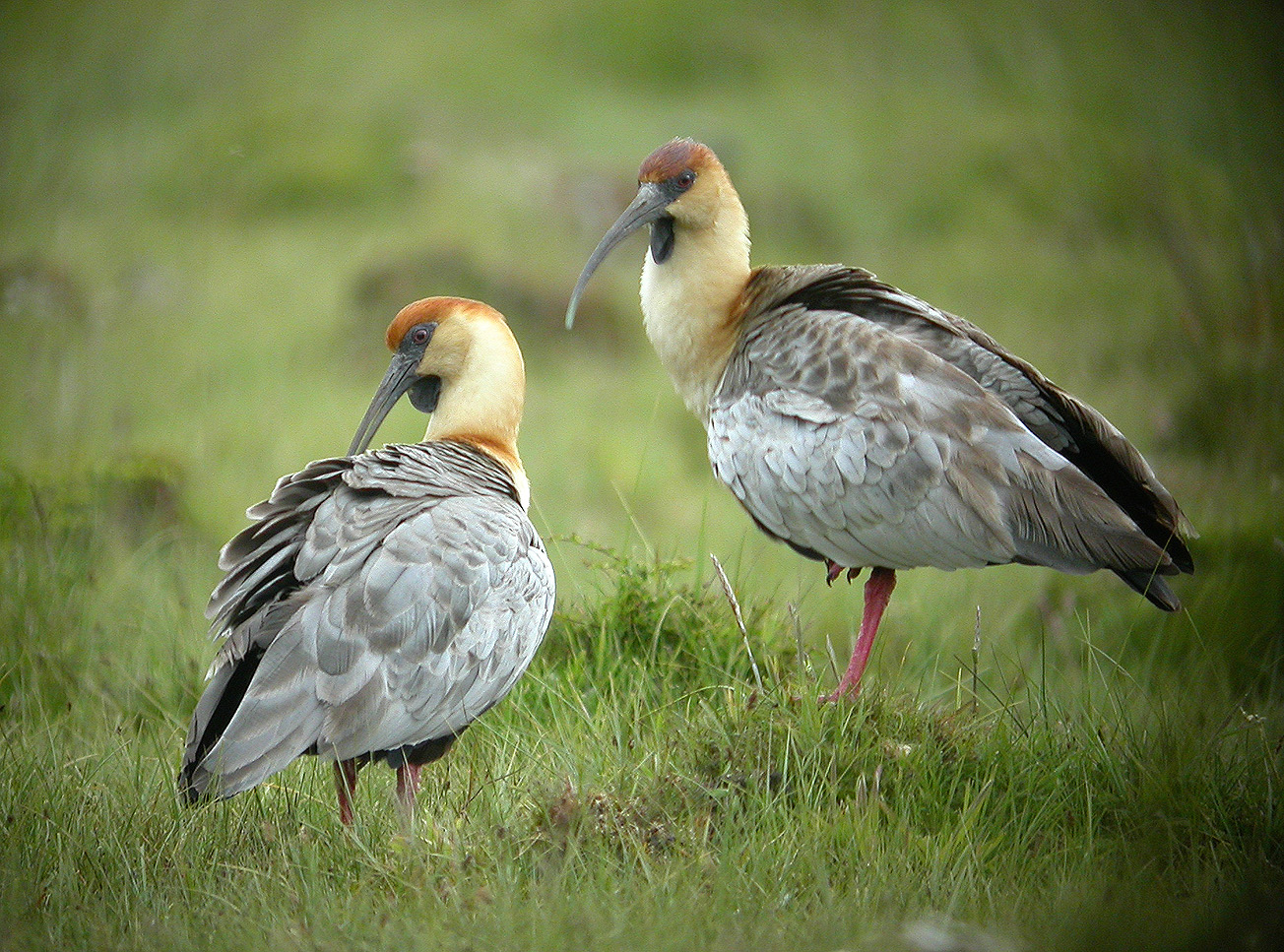
Order:
Pelecaniformes
The Pelecaniformes are an order of medium-sized and large waterbirds found worldwide. As traditionally—but erroneously—defined, they encompass all birds that have feet with all four toes webbed. Hence, they were formerly also known by such n ...
Family:
Threskiornithidae
The family Threskiornithidae includes 36 species of large wading birds. The family has been traditionally classified into two subfamilies, the ibises and the spoonbills; however recent genetic studies have cast doubt on this arrangement, and hav ...
Threskiornithidae is a family of large terrestrial and wading birds which includes the
ibis
The ibises () (collective plural ibis; classical plurals ibides and ibes) are a group of long-legged wading birds in the family Threskiornithidae, that inhabit wetlands, forests and plains. "Ibis" derives from the Latin and Ancient Greek word f ...
es and
spoonbill
Spoonbills are a genus, ''Platalea'', of large, long-legged wading birds. The spoonbills have a global distribution, being found on every continent except Antarctica. The genus name ''Platalea'' derives from Ancient Greek and means "broad", refe ...
s. They have long, broad wings with 11 primary and about 20 secondary feathers. They are strong fliers and despite their size and weight, very capable soarers. Six species have been recorded in Chile.
*
White-faced ibis
The white-faced ibis (''Plegadis chihi'') is a wading bird in the ibis family, Threskiornithidae.
This species breeds colonially in marshes, usually nesting in bushes or low trees. Its breeding range extends from the western United States south ...
, ''Plegadis chihi''
*
Puna ibis, ''Plegadis ridgwayi''
*
Bare-faced ibis, ''Phimosus infuscatus'' (V)
*
Andean ibis
The Andean ibis (''Theristicus branickii'') is a species of bird in the family Threskiornithidae. It is found in grassland and fields in western South America. This species was considered a subspecies of the black-faced ibis, and some taxonomic a ...
, ''Theristicus branickii''
*
Black-faced ibis
The black-faced ibis (''Theristicus melanopis'') is a species of bird in the family Threskiornithidae. It is found in grassland and fields in southern and western South America. It has been included as a subspecies of the similar buff-necked ...
, ''Theristicus melanopis''
*
Roseate spoonbill
The roseate spoonbill (''Platalea ajaja'') is a gregarious wading bird of the ibis and spoonbill family, Threskiornithidae. It is a resident breeder in both South and North America.
Taxonomy
The roseate spoonbill is sometimes placed in its o ...
, ''Platalea ajaja'' (V)
New World vultures

Order:
Cathartiformes
The order Cathartiformes of raptors or birds of prey includes the New World vultures and the now-extinct Teratornithidae. These raptors are classified by most taxonomic authorities in the order Accipitriformes (which includes the eagles and h ...
Family: Cathartidae
The New World vultures are not closely related to Old World vultures, but superficially resemble them because of convergent evolution. Like the Old World vultures, they are scavengers. However, unlike Old World vultures, which find carcasses by sight, New World vultures have a good sense of smell with which they locate carrion. Three species have been recorded in Chile.
*Andean condor, ''Vultur gryphus''
*Black vulture, ''Coragyps atratus''
*Turkey vulture, ''Cathartes aura''
Osprey
Order: AccipitriformesFamily: Pandionidae
The family Pandionidae contains only one species, the osprey. The osprey is a medium-large bird of prey, raptor which is a specialist fish-eater with a worldwide distribution.
*Osprey, ''Pandion haliaetus''
Hawks

Order: AccipitriformesFamily: Accipitridae
Accipitridae is a family of birds of prey, which includes hawks, eagles, Kite (bird), kites, Harrier (bird), harriers and Old World vultures. These birds have powerful hooked beaks for tearing flesh from their prey, strong legs, powerful talons and keen eyesight. Ten species have been recorded in Chile.
*White-tailed kite, ''Elanus leucurus''
*Cinereous harrier, ''Circus cinereus''
*Long-winged harrier, ''Circus buffoni'' (V)
*Bicolored hawk, ''Accipter bicolor''
*Harris's hawk, ''Parabuteo unicinctus''
*Variable hawk, ''Geranoaetus polyosoma''
*Black-chested buzzard-eagle, ''Geranoaetus melanoleucus''
*White-throated hawk, ''Buteo albigula''
*Swainson's hawk, ''Buteo swainsoni'' (V)
*Rufous-tailed hawk, ''Buteo ventralis''
Barn owls
Order: StrigiformesFamily: Tytonidae
Barn owls are medium to large owls with large heads and characteristic heart-shaped faces. They have long strong legs with powerful talons. One species has been recorded in Chile.
*Barn owl, ''Tyto alba''
Owls
Order: StrigiformesFamily: Strigidae
The typical owls are small to large solitary nocturnal birds of prey. They have large forward-facing eyes and ears, a hawk-like beak and a conspicuous circle of feathers around each eye called a facial disk. Six species have been recorded in Chile.
*Great horned owl, ''Bubo virginianus''
*Rufous-legged owl, ''Strix rufipes''
*Peruvian pygmy-owl, ''Glaucidium peruanum''
*Austral pygmy-owl, ''Glaucidium nanum''
*Burrowing owl, ''Athene cunicularia''
*Short-eared owl, ''Asio flammeus''
Kingfishers
Order: CoraciiformesFamily: Alcedinidae
Kingfishers are medium-sized birds with large heads, long pointed bills, short legs, and stubby tails. Two species have been recorded in Chile.
*Ringed kingfisher, ''Megaceryle torquatus''
*Green kingfisher, ''Chloroceryle americana'' (V)
Woodpeckers


Order: PiciformesFamily: Picidae
Woodpeckers are small to medium-sized birds with chisel-like beaks, short legs, stiff tails and long tongues used for capturing insects. Some species have feet with two toes pointing forward and two backward, while several species have only three toes. Many woodpeckers have the habit of tapping noisily on tree trunks with their beaks. Four species have been recorded in Chile.
*Striped woodpecker, ''Dryobates lignarius''
*Magellanic woodpecker, ''Campephilus magellanicus''
*Chilean flicker, ''Colaptes pitius''
*Andean flicker, ''Colaptes rupicola''
Falcons
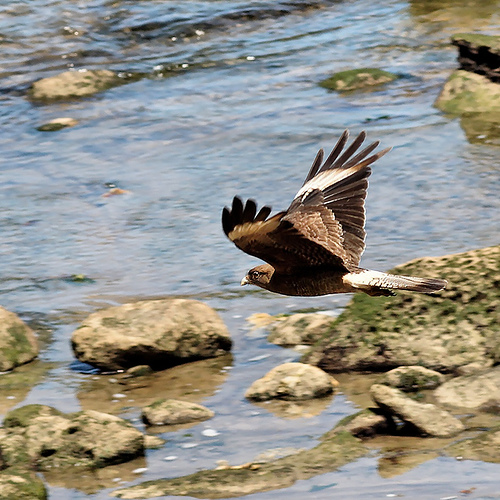
Order: FalconiformesFamily: Falconidae
Falconidae is a family of diurnal birds of prey. They differ from hawks, eagles and kites in that they kill with their beaks instead of their talons. Nine species have been recorded in Chile.
*Crested caracara, ''Caracara plancus''
*Mountain caracara, ''Phalcoboenus megalopterus''
*White-throated caracara, ''Phalcoboenus albogularis''
*Striated caracara, ''Phalcoboenus australis''
*Chimango caracara, ''Milvago chimango''
*American kestrel, ''Falco sparverius''
*Orange-breasted falcon, ''Falco deiroleucus'' (V)
*Aplomado falcon, ''Falco femoralis''
*Peregrine falcon, ''Falco peregrinus''
New World and African parrots

Order: PsittaciformesFamily: Psittacidae
Parrots are small to large birds with a characteristic curved beak. Their upper mandibles have slight mobility in the joint with the skull and they have a generally erect stance. All parrots are zygodactyl, having the four toes on each foot placed two at the front and two to the back. Five species have been recorded in Chile.
*Mountain parakeet, ''Psilopsiagon aurifrons''
*Monk parakeet, ''Myiopsitta monachus'' (I)
*Austral parakeet, ''Enicognathus ferrugineus''
*Slender-billed parakeet, ''Enicognathus leptorhynchus'' (E)
*Burrowing parakeet, ''Cyanoliseus patagonus''
Tapaculos
Order: PasseriformesFamily: Rhinocryptidae
The tapaculos are small suboscine passeriform birds with numerous species in South and Central America. They are terrestrial species that fly only poorly on their short wings. They have strong legs, well-suited to their habitat of grassland or forest undergrowth. The tail is cocked and pointed. Eight species have been recorded in Chile.
*Chestnut-throated huet-huet, ''Pteroptochos castaneus''
*Black-throated huet-huet, ''Pteroptochos tarnii''
*Moustached turca, ''Pteroptochos megapodius'' (E)
*White-throated tapaculo, ''Scelorchilus albicollis'' (E)
*Chucao tapaculo, ''Scelorchilus rubecula''
*Ochre-flanked tapaculo, ''Eugralla paradoxa''
*Dusky tapaculo, ''Scytalopus fuscus'' (E)
*Magellanic tapaculo, ''Scytalopus magellanicus''
Ovenbirds
Order: PasseriformesFamily: Furnariidae
Ovenbirds comprise a large family of small sub-oscine passerine bird species found in Central and South America. They are a diverse group of insectivores which gets its name from the elaborate "oven-like" clay nests built by some species, although others build stick nests or nest in tunnels or clefts in rock. Thirty-four species have been recorded in Chile.
*Common miner, ''Geositta cunicularia''
*Puna miner, ''Geositta punensis''
*Rufous-banded miner, ''Geositta rufipennis''
*Grayish miner, ''Geositta maritima''
*Short-billed miner, ''Geositta antarctica''
*Creamy-rumped miner, ''Geositta isabellina''
*White-throated treerunner, ''Pygarrhichas albogularis''
*Rock earthcreeper, ''Ochetorhynchus andaecola'' (V)
*Straight-billed earthcreeper, ''Ochetorhynchus ruficaudus''
*Band-tailed earthcreeper, ''Ochetorhynchus phoenicurus''
*Crag chilia, ''Ochetorhynchus melanurus'' (E)
*Wren-like rushbird, ''Phleocryptes melanops''
*Patagonian forest earthcreeper, ''Upucerthia saturatior''
*Scale-throated earthcreeper, ''Upucerthia dumetaria''
*White-throated earthcreeper, ''Upucerthia albigula''
*Buff-breasted earthcreeper, ''Upucerthia validirostris''
*Buff-winged cinclodes, ''Cinclodes fuscus''
*Blackish cinclodes, ''Cinclodes antarcticus''
*Cream-winged cinclodes, ''Cinclodes albiventris''
*Gray-flanked cinclodes, ''Cinclodes oustaleti''
*White-winged cinclodes, ''Cinclodes atacamensis''
*Dark-bellied cinclodes, ''Cinclodes patagonicus''
*Chilean seaside cinclodes, Seaside cinclodes, ''Cinclodes nigrofumosus'' (E)
*Thorn-tailed rayadito, ''Aphrastura spinicauda''
*Masafuera rayadito, ''Aphrastura masafuerae'' (E)
*Des Murs's wiretail, ''Sylviorthorhynchus desmursii''
*Plain-mantled tit-spinetail, ''Leptasthenura aegithaloides''
*Streaked tit-spinetail, ''Leptasthenura striata''
*Creamy-breasted canastero, ''Asthenes dorbignyi''
*Austral canastero, ''Asthenes anthoides''
*Cordilleran canastero, ''Asthenes modesta''
*Sharp-billed canastero, ''Asthenes pyrrholeuca''
*Canyon canastero, ''Asthenes pudibunda''
*Dusky-tailed canastero, ''Asthenes humicola'' (E)
Cotingas
Order: PasseriformesFamily: Cotingidae
The cotingas are birds of forests or forest edges in tropical South America. Comparatively little is known about this diverse group, although all have broad bills with hooked tips, rounded wings and strong legs. The males of many of the species are brightly colored or decorated with plumes or wattles. One species has been recorded in Chile.
*Rufous-tailed plantcutter, ''Phytotoma rara''
Tyrant flycatchers

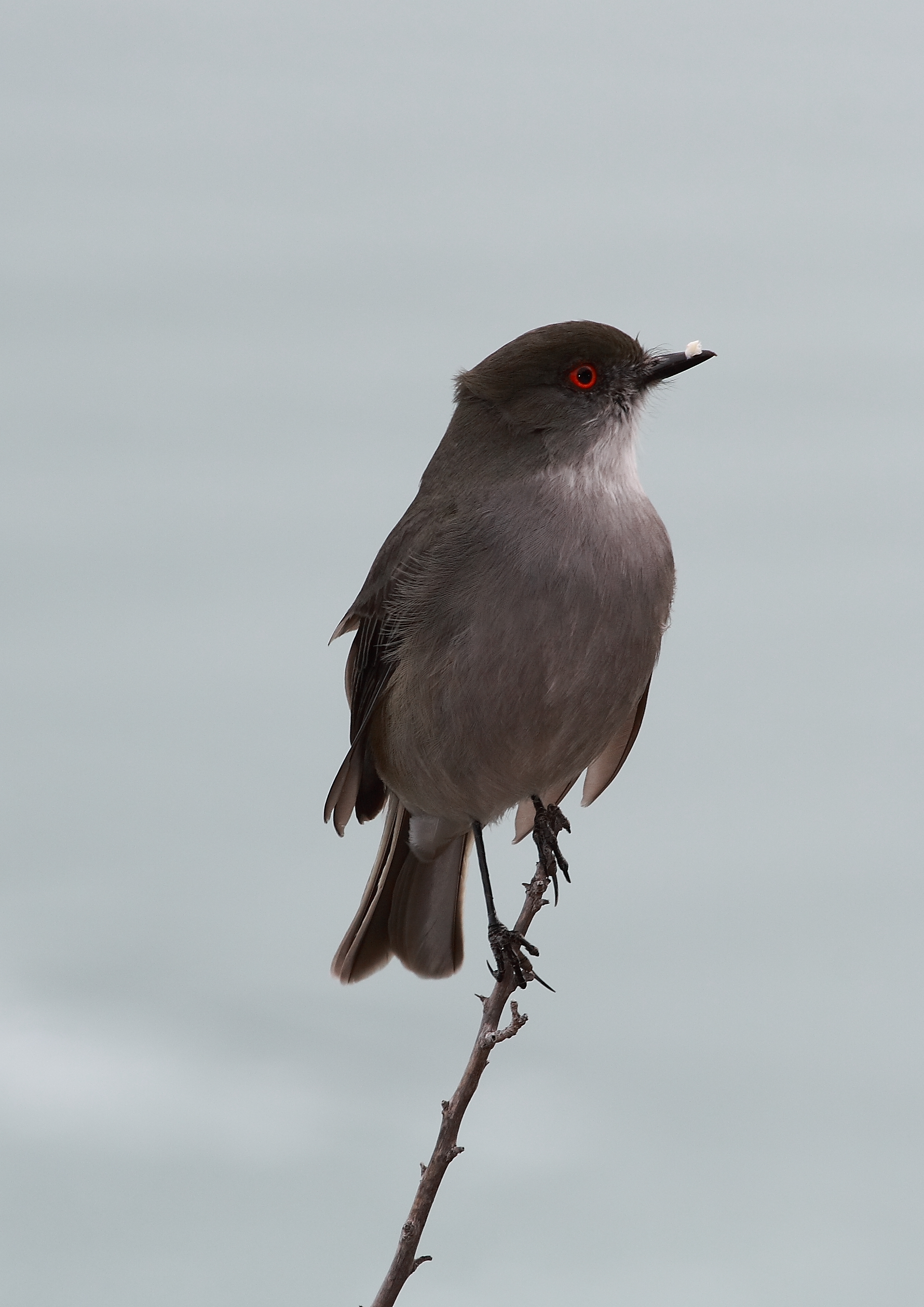
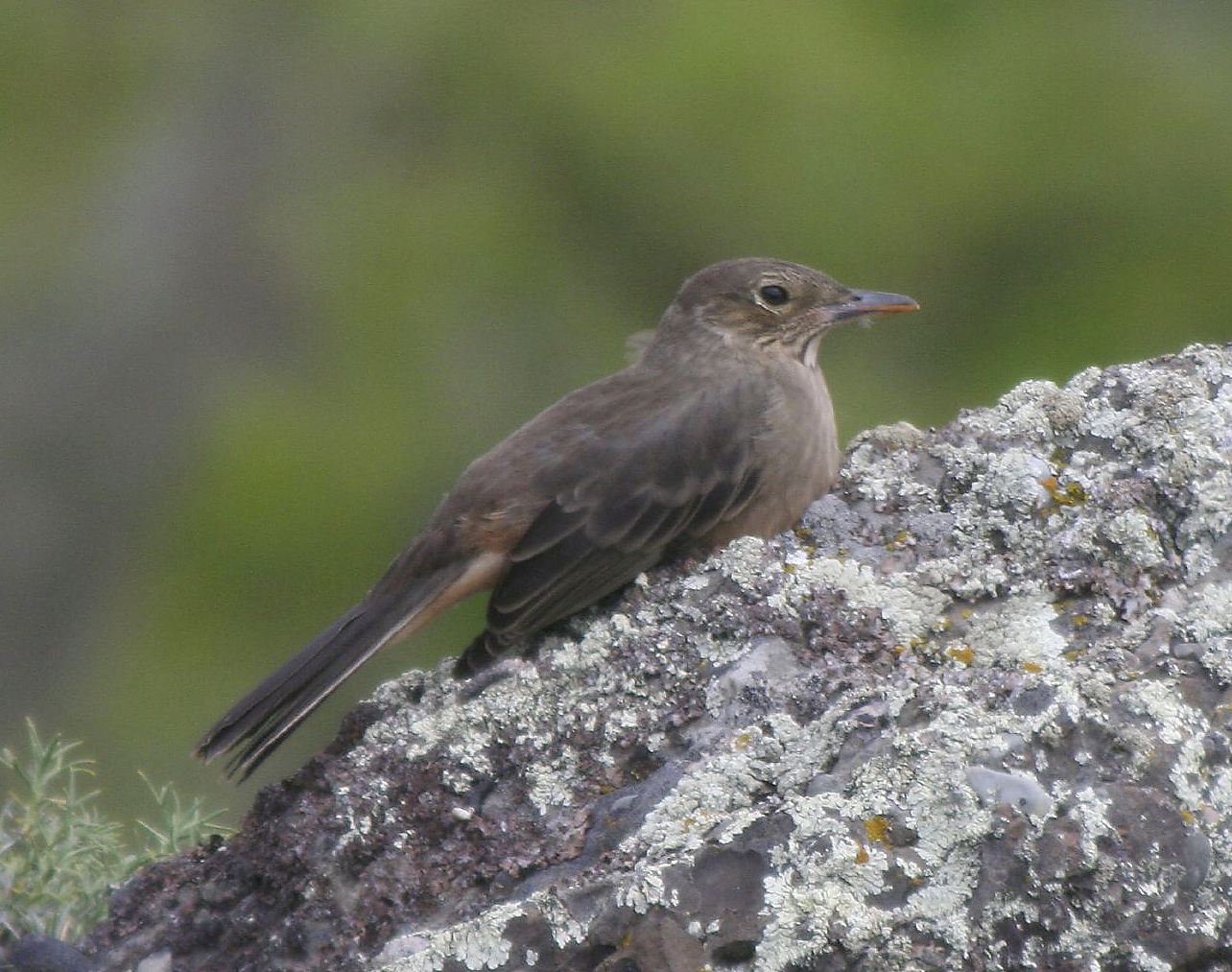
Order: PasseriformesFamily: Tyrannidae
Tyrant flycatchers are passerine birds which occur throughout North and South America. They superficially resemble the Old World flycatchers, but are more robust and have stronger bills. They do not have the sophisticated vocal capabilities of the songbirds. Most, but not all, have plain coloring. As the name implies, most are insectivorous. Forty-nine species have been recorded in Chile.
*Cliff flycatcher, ''Hirundinea ferruginea'' (H)
*White-crested elaenia, ''Elaenia albiceps''
*Pied-crested tit-tyrant, ''Anairetes reguloides''
*Yellow-billed tit-tyrant, ''Anairetes flavirostris''
*Tufted tit-tyrant, ''Anairetes parulus''
*Juan Fernandez tit-tyrant, ''Anairetes fernandezianus'' (E)
*Ticking doradito, ''Pseudocolopteryx citreola''
*Short-tailed field tyrant, ''Muscigralla brevicauda'' (V)
*Great kiskadee, ''Pitangus sulphuratus'' (V)
*Cattle tyrant, ''Machetornis rixosa'' (V)
*Boat-billed flycatcher, ''Megarynchus pitangua'' (V)
*Sulphur-bellied flycatcher, ''Myiodynastes luteiventris'' (V)
*Streaked flycatcher, ''Myiodynastes maculatus'' (V)
*Crowned slaty flycatcher, ''Empidonomus aurantioatrocristatus'' (V)
*Tropical kingbird, ''Tyrannus melancholicus'' (V)
*Fork-tailed flycatcher, ''Tyrannus savana'' (V)
*Eastern kingbird, ''Tyrannus tyrannus'' (V)
*Rufous casiornis, ''Casiornis rufus'' (V)
*Bran-colored flycatcher, ''Myiophobus fasciatus''
*Patagonian tyrant, ''Colorhamphus parvirostris''
*d'Orbigny's chat-tyrant, ''Ochthoeca oenanthoides''
*White-browed chat-tyrant, ''Ochthoeca leucophrys''
*Vermilion flycatcher, ''Pyrocephalus rubinus''
*Austral negrito, ''Lessonia rufa''
*Andean negrito, ''Lessonia oreas''
*Spectacled tyrant, ''Hymenops perspicillatus''
*White-winged black-tyrant, ''Knipolegus aterrimus'' (H)
*Spot-billed ground-tyrant, ''Muscisaxicola maculirostris''
*Puna ground-tyrant, ''Muscisaxicola juninensis''
*Cinereous ground-tyrant, ''Muscisaxicola cinereus''
*White-fronted ground-tyrant, ''Muscisaxicola albifrons''
*Ochre-naped ground-tyrant, ''Muscisaxicola flavinucha''
*Rufous-naped ground-tyrant, ''Muscisaxicola rufivertex''
*Dark-faced ground-tyrant, ''Muscisaxicola maclovianus''
*White-browed ground-tyrant, ''Muscisaxicola albilora''
*Cinnamon-bellied ground-tyrant, ''Muscisaxicola capistratus''
*Black-fronted ground-tyrant, ''Muscisaxicola frontalis''
*Rufous-webbed bush-tyrant, ''Cnemarchus rufipennis''
*Fire-eyed diucon, ''Pyrope pyrope''
*Black-crowned monjita, ''Neoxolmis coronatus'' (V)
*Chocolate-vented tyrant, ''Neoxolmis rufiventris''
*Rusty-backed monjita, ''Neoxolmis rubetra'' (V)
*Black-billed shrike-tyrant, ''Agriornis montanus''
*White-tailed shrike-tyrant, ''Agriornis albicauda''
*Great shrike-tyrant, ''Agriornis lividus''
*Gray-bellied shrike-tyrant, ''Agriornis micropterus''
*Lesser shrike-tyrant, ''Agriornis murinus'' (V)
*Western wood-pewee, ''Contopus sordidulus'' (V)
*Many-colored rush tyrant, ''Tachuris rubrigastra''
Vireos
Order: PasseriformesFamily: Vireonidae
The vireos are a group of small to medium-sized passerine birds. They are typically greenish in color and resemble New World warbler, wood warblers apart from their heavier bills. Two species have been recorded in Chile.
*Red-eyed vireo, ''Vireo olivaceus'' (V)
*Chivi vireo, ''Vireo chivi'' (V)
Swallows
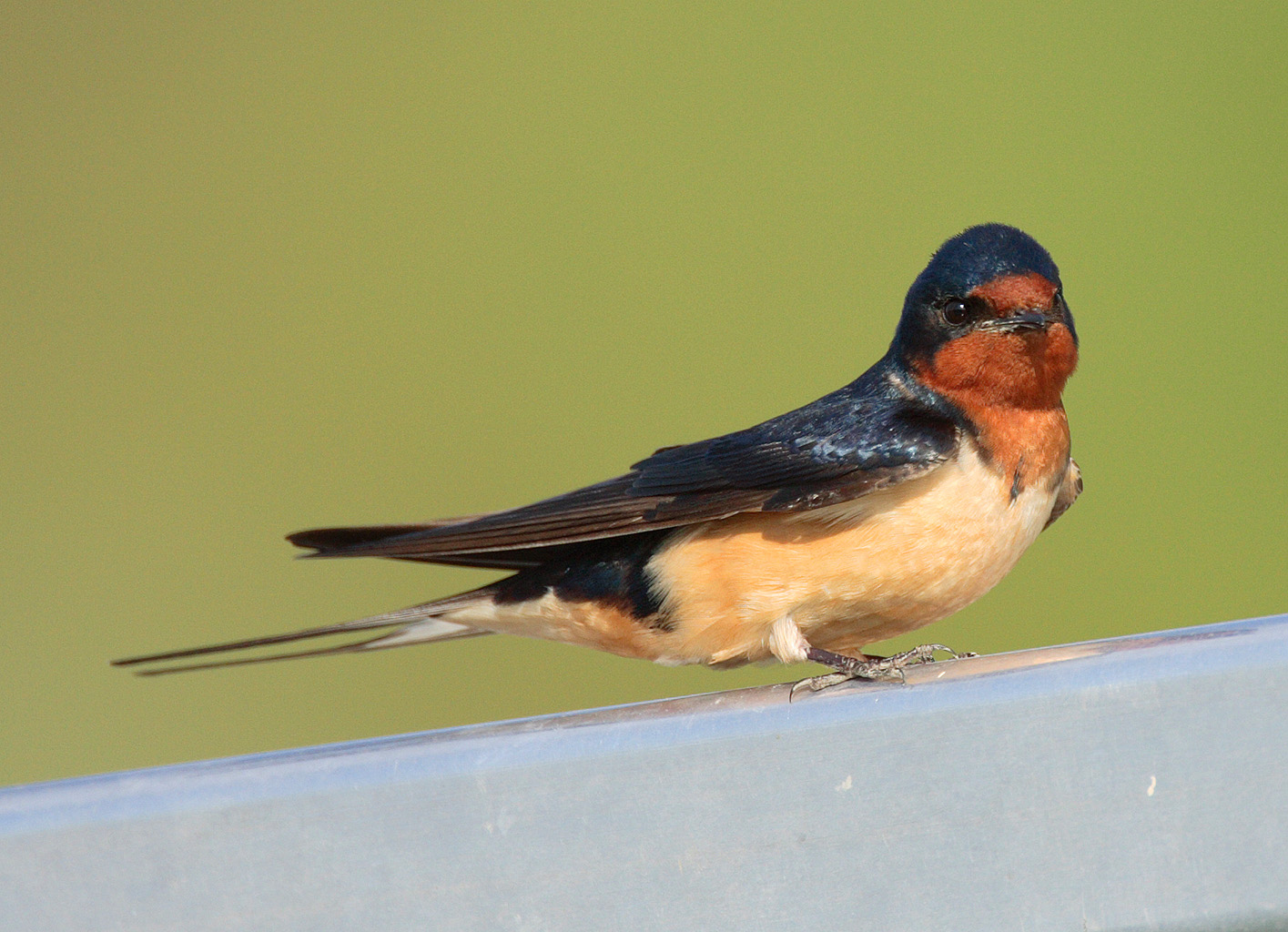
Order: PasseriformesFamily: Hirundinidae
The family Hirundinidae is adapted to aerial feeding. They have a slender streamlined body, long pointed wings and a short bill with a wide gape. The feet are adapted to perching rather than walking, and the front toes are partially joined at the base. Eleven species have been recorded in Chile.
*Blue-and-white swallow, ''Pygochelidon cyanoleuca''
*Tawny-headed swallow, ''Alopochelidon fucata'' (V)
*Andean swallow, ''Orochelidon andecola''
*Brown-chested martin, ''Progne tapera'' (V)
*Gray-breasted martin, ''Progne chalybea'' (V)
*Southern martin, ''Progne elegans''
*Peruvian martin, ''Progne murphyi''
*Chilean swallow, ''Tachycineta leucopyga''
*Bank swallow, ''Riparia riparia''
*Barn swallow, ''Hirundo rustica''
*American cliff swallow, Cliff swallow, ''Petrochelidon pyrrhonota''
Wrens

Order: PasseriformesFamily: Troglodytidae
The wrens are mainly small and inconspicuous except for their loud songs. These birds have short wings and thin down-turned bills. Several species often hold their tails upright. All are insectivorous. Two species have been recorded in Chile.
*House wren, ''Troglodytes aedon''
*Grass wren, ''Cistothorus platensis''
Thrushes

Order: PasseriformesFamily: Turdidae
The Thrush (bird), thrushes are a group of passerine birds that occur mainly in the Old World. They are plump, soft plumaged, small to medium-sized insectivores or sometimes omnivores, often feeding on the ground. Many have attractive songs. Five species have been recorded in Chile.
*Veery, ''Catharus fuscescens'' (V)
*Swainson's thrush, ''Catharus ustulatus'' (V)
*Austral thrush, ''Turdus falcklandii''
*Creamy-bellied thrush, ''Turdus amaurochalinus'' (V)
*Chiguanco thrush, ''Turdus chiguanco''
Mockingbirds

Order: PasseriformesFamily: Mimidae
The mimids are a family of passerine birds that includes thrashers, mockingbirds, tremblers and the New World catbirds. These birds are notable for their vocalizations, especially their ability to mimic a wide variety of birds and other sounds heard outdoors. Their coloring tends towards dull-grays and browns. Five species have been recorded in Chile.
*Long-tailed mockingbird, ''Mimus longicaudatus'' (H)
*Chilean mockingbird, ''Mimus thenca''
*Patagonian mockingbird, ''Mimus patagonicus''
*Chalk-browed mockingbird, ''Mimus saturninus'' (V)
*White-banded mockingbird, ''Mimus triurus''
Starlings
Order: PasseriformesFamily: Sturnidae
Starlings are small to medium-sized passerine birds. Their flight is strong and direct and they are very gregarious. Their preferred habitat is fairly open country. They eat insects and fruit. Plumage is typically dark with a metallic sheen. One species has been recorded in Chile.
*European starling, ''Sturnus vulgaris'' (I) (V)
Old World sparrows

Order: PasseriformesFamily: Passeridae
Old World sparrow, Sparrows are small passerine birds. In general, sparrows tend to be small, plump, brown or gray birds with short tails and short powerful beaks. Sparrows are seed eaters, but they also consume small insects. One species has been recorded in Chile.
*House sparrow, ''Passer domesticus'' (I)
Pipits and wagtails
Order: PasseriformesFamily: Motacillidae
Motacillidae is a family of small passerine birds with medium to long tails. They include the wagtails, longclaws, and pipits. They are slender ground-feeding insectivores of open country. Three species have been recorded in Chile.
*Peruvian pipit, ''Anthus peruvianus''
*Correndera pipit, ''Anthus correndera''
*Hellmayr's pipit, ''Anthus hellmayri''
Finches

Order: PasseriformesFamily: Fringillidae
Finches are seed-eating passerine birds, that are small to moderately large and have a strong beak, usually conical and in some species very large. All have twelve tail feathers and nine primaries. These birds have a bouncing flight with alternating bouts of flapping and gliding on closed wings, and most sing well. Five species have been recorded in Chile.
*Thick-billed siskin, ''Spinus crassirostris''
*Hooded siskin, ''Spinus magellanica''
*Black siskin, ''Spinus atrata''
*Yellow-rumped siskin, ''Spinus uropygialis''
*Black-chinned siskin, ''Spinus barbata''
Sparrows

Order: PasseriformesFamily: Passerellidae
Most of the species are known as sparrows, but these birds are not closely related to the Old World sparrows which are in the family Passeridae. Many of these have distinctive head patterns. One species has been recorded in Chile.
*Rufous-collared sparrow, ''Zonotrichia capensis''
Blackbirds
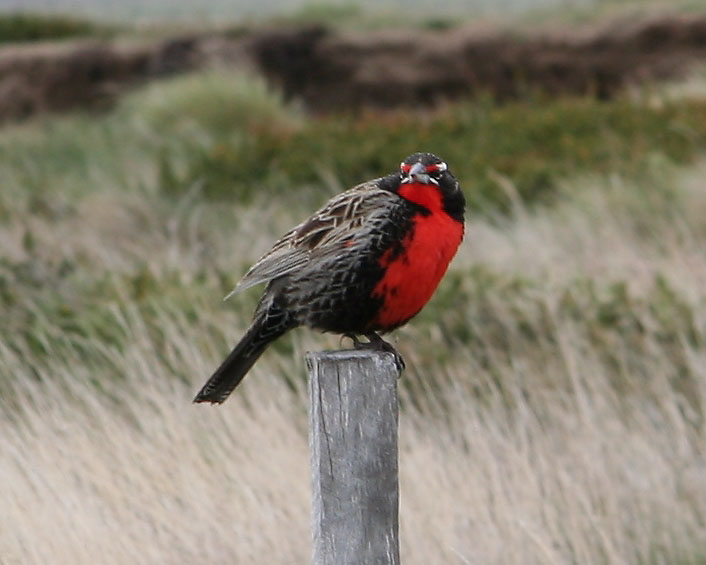
Order: PasseriformesFamily: Icteridae
The icterids are a group of small to medium-sized, often colorful, passerine birds restricted to the New World and include the grackles, New World blackbirds and New World orioles. Most species have black as the predominant plumage color, often enlivened by yellow, orange or red. Eleven species have been recorded in Chile.
*Bobolink, ''Dolichonyx oryzivorus'' (V)
*White-browed meadowlark, ''Leistes superciliaris'' (V)
*Peruvian meadowlark, ''Leistes bellicosa''
*Long-tailed meadowlark, ''Leistes loyca''
*Variable oriole, ''Icterus pyrrhopterus'' (V)
*Baltimore oriole, ''Icterus galbula'' (V)
*Screaming cowbird, ''Molothrus rufoaxillaris''
*Shiny cowbird, ''Molothrus bonariensis'' (I)
*Austral blackbird, ''Curaeus curaeus''
*Grayish baywing, ''Agelaioides badius'' (H)
*Yellow-winged blackbird, ''Agelasticus thilius''
Wood-warblers
Order: PasseriformesFamily: Parulidae
The wood-warblers are a group of small, often colorful, passerine birds restricted to the New World. Most are arboreal, but some are terrestrial. Most members of this family are insectivores. Nine species have been recorded in Chile.
*Northern waterthrush, ''Parkesia noveboracensis'' (V)
*Tennessee warbler, ''Oreothlypis peregrina'' (V)
*Masked yellowthroat, ''Geothlypis aequinoctialis'' (V)
*American redstart, ''Setophaga ruticilla'' (V)
*Tropical parula, ''Setophaga pitiayumi'' (V)
*Blackburnian warbler, ''Setophaga fusca'' (V)
*Blackpoll warbler, ''Setophaga striata'' (V)
*Black-throated green warbler, ''Setophaga virens'' (V)
*Canada warbler, ''Cardellina canadensis'' (V)
Cardinal grosbeaks
Order: PasseriformesFamily: Cardinalidae
The cardinals are a family of robust, seed-eating birds with strong bills. They are typically associated with open woodland. The sexes usually have distinct plumages. Two species have been recorded in Chile.
*Summer tanager, ''Piranga rubra'' (V)
*Black-backed grosbeak, ''Pheucticus aureoventris'' (V)
Tanagers
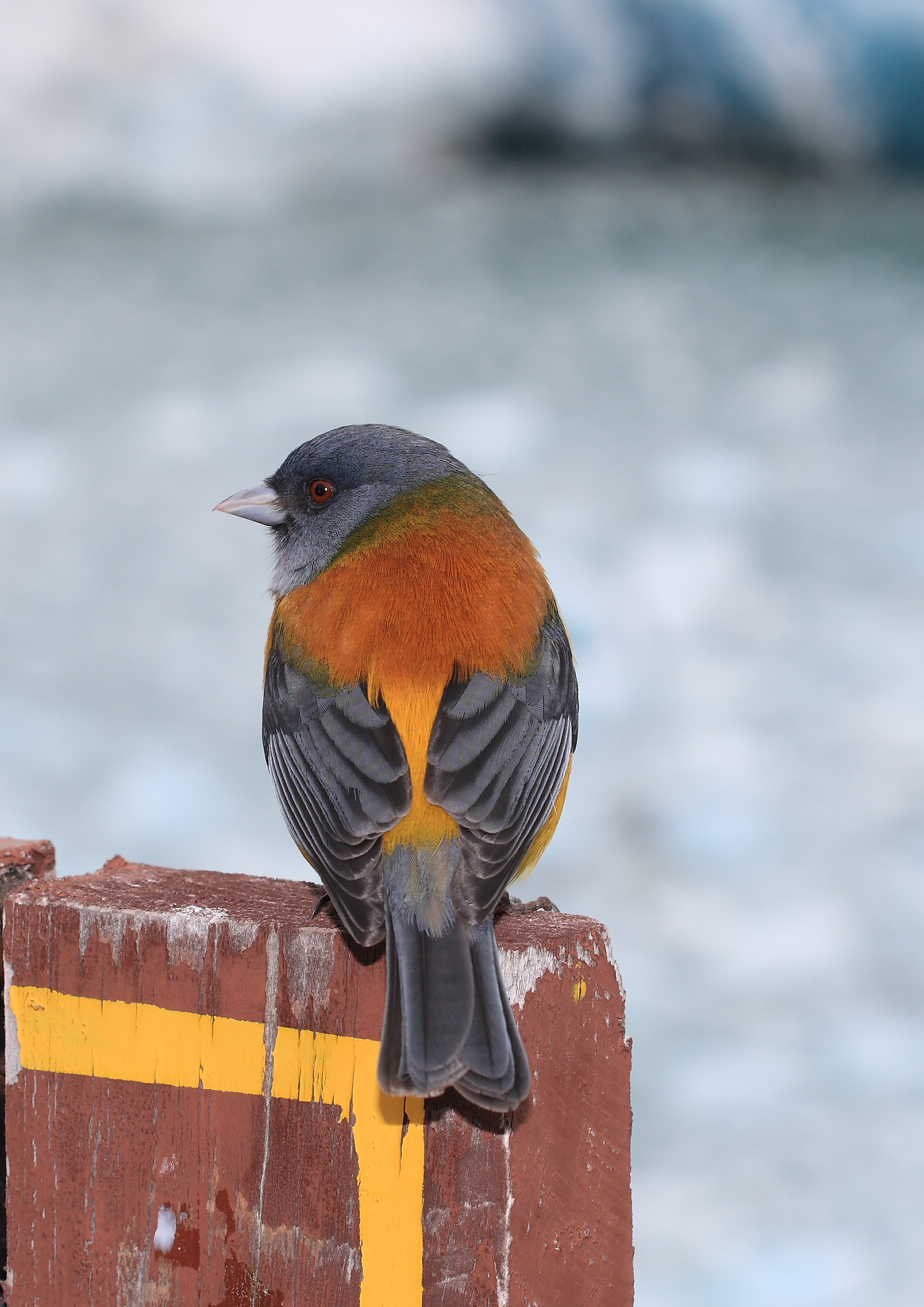
Order: PasseriformesFamily: Thraupidae
The tanagers are a large group of small to medium-sized passerine birds restricted to the New World, mainly in the tropics. Many species are brightly colored. As a family they are omnivorous, but individual species specialize in eating fruits, seeds, insects, or other types of food. Thirty-five species have been recorded in Chile.
*Giant conebill, ''Conirostrum binghami''
*Tamarugo conebill, ''Conirostrum tamarugense''
*Cinereous conebill, ''Conirostrum cinereum''
*Puna yellow-finch, ''Sicalis lutea''
*Bright-rumped yellow-finch, ''Sicalis uropygialis''
*Greater yellow-finch, ''Sicalis auriventris''
*Greenish yellow-finch, ''Sicalis olivascens''
*Patagonian yellow-finch, ''Sicalis lebruni''
*Saffron finch, ''Sicalis flaveola''
*Grassland yellow-finch, ''Sicalis luteola''
*Raimondi's yellow-finch, ''Sicalis raimondii''
*Black-hooded sierra finch, ''Phrygilus atriceps''
*Gray-hooded sierra finch, ''Phrygilus gayi''
*Patagonian sierra finch, ''Phrygilus patagonicus''
*Mourning sierra finch, ''Phrygilus fruticeti''
*Red-backed sierra finch, ''Phrygilus dorsalis''
*White-throated sierra finch, ''Phrygilus erythronotus''
*Band-tailed sierra finch, ''Phrygilus alaudinus''
*Plumbeous sierra finch, ''Geospizopsis unicolor''
*Ash-breasted sierra finch, ''Geospizopsis plebejus''
*White-bridled finch, ''Melanodera melanodera''
*Yellow-bridled finch, ''Melanodera xanthogramma''
*Band-tailed seedeater, ''Catamenia analis''
*Black-throated flowerpiercer, ''Diglossa brunneiventris''
*Blue-black grassquit, ''Volatinia jacarina''
*Swallow tanager, ''Tersina viridis'' (V)
*Lined seedeater, ''Sporophila lineola'' (V)
*Chestnut-throated seedeater, ''Sporophila telasco''
*Double-collared seedeater, ''Sporophila caerulescens'' (V)
*Golden-billed saltator, ''Saltator aurantiirostris''
*Slender-billed finch, ''Xenospingus concolor''
*Ringed warbling finch, ''Microspingus torquatus'' (V)
*Glacier finch, ''Diuca speculifer''
*Diuca finch, ''Diuca diuca''
*Blue-and-yellow tanager, ''Rauenia bonariensis''
See also
* Wildlife of Chile
*List of birds
*Lists of birds by region
References
External links
Birds of Chile for the country and by region- World Institute for Conservation and Environment
{{DEFAULTSORT:List Of Birds Of Chile
Lists of birds by country, Chile
Birds of Chile,
Lists of biota of Chile, Birds
Lists of birds of South America, Chile
 Order: RheiformesFamily: Rheidae
The rheas are large flightless birds native to South America. Their feet have three toes rather than four which allows them to run faster. One species has been recorded in Chile.
*
Order: RheiformesFamily: Rheidae
The rheas are large flightless birds native to South America. Their feet have three toes rather than four which allows them to run faster. One species has been recorded in Chile.
*

 Order: PhoenicopteriformesFamily: Phoenicopteridae
Order: PhoenicopteriformesFamily: Phoenicopteridae
 Order: PodicipediformesFamily: Podicipedidae
Order: PodicipediformesFamily: Podicipedidae
 Order: ColumbiformesFamily:
Order: ColumbiformesFamily:  Order: CuculiformesFamily: Cuculidae
The family Cuculidae includes
Order: CuculiformesFamily: Cuculidae
The family Cuculidae includes  Order:
Order: 
 Order: GruiformesFamily:
Order: GruiformesFamily:  Order:
Order:  Order:
Order:  Order:
Order:  Order:
Order: 

 Order:
Order: 

 Order:
Order:  Order: PhaethontiformesFamily:
Order: PhaethontiformesFamily:  Order: SphenisciformesFamily: Spheniscidae
The penguins are a group of aquatic, flightless birds living almost exclusively in the Southern Hemisphere. Most penguins feed on
Order: SphenisciformesFamily: Spheniscidae
The penguins are a group of aquatic, flightless birds living almost exclusively in the Southern Hemisphere. Most penguins feed on  Order:
Order:  Order: SuliformesFamily:
Order: SuliformesFamily:  Order:
Order:  Order:
Order:  Order:
Order:  Order: AccipitriformesFamily: Accipitridae
Accipitridae is a family of birds of prey, which includes hawks, eagles, Kite (bird), kites, Harrier (bird), harriers and Old World vultures. These birds have powerful hooked beaks for tearing flesh from their prey, strong legs, powerful talons and keen eyesight. Ten species have been recorded in Chile.
*White-tailed kite, ''Elanus leucurus''
*Cinereous harrier, ''Circus cinereus''
*Long-winged harrier, ''Circus buffoni'' (V)
*Bicolored hawk, ''Accipter bicolor''
*Harris's hawk, ''Parabuteo unicinctus''
*Variable hawk, ''Geranoaetus polyosoma''
*Black-chested buzzard-eagle, ''Geranoaetus melanoleucus''
*White-throated hawk, ''Buteo albigula''
*Swainson's hawk, ''Buteo swainsoni'' (V)
*Rufous-tailed hawk, ''Buteo ventralis''
Order: AccipitriformesFamily: Accipitridae
Accipitridae is a family of birds of prey, which includes hawks, eagles, Kite (bird), kites, Harrier (bird), harriers and Old World vultures. These birds have powerful hooked beaks for tearing flesh from their prey, strong legs, powerful talons and keen eyesight. Ten species have been recorded in Chile.
*White-tailed kite, ''Elanus leucurus''
*Cinereous harrier, ''Circus cinereus''
*Long-winged harrier, ''Circus buffoni'' (V)
*Bicolored hawk, ''Accipter bicolor''
*Harris's hawk, ''Parabuteo unicinctus''
*Variable hawk, ''Geranoaetus polyosoma''
*Black-chested buzzard-eagle, ''Geranoaetus melanoleucus''
*White-throated hawk, ''Buteo albigula''
*Swainson's hawk, ''Buteo swainsoni'' (V)
*Rufous-tailed hawk, ''Buteo ventralis''

 Order: PiciformesFamily: Picidae
Woodpeckers are small to medium-sized birds with chisel-like beaks, short legs, stiff tails and long tongues used for capturing insects. Some species have feet with two toes pointing forward and two backward, while several species have only three toes. Many woodpeckers have the habit of tapping noisily on tree trunks with their beaks. Four species have been recorded in Chile.
*Striped woodpecker, ''Dryobates lignarius''
*Magellanic woodpecker, ''Campephilus magellanicus''
*Chilean flicker, ''Colaptes pitius''
*Andean flicker, ''Colaptes rupicola''
Order: PiciformesFamily: Picidae
Woodpeckers are small to medium-sized birds with chisel-like beaks, short legs, stiff tails and long tongues used for capturing insects. Some species have feet with two toes pointing forward and two backward, while several species have only three toes. Many woodpeckers have the habit of tapping noisily on tree trunks with their beaks. Four species have been recorded in Chile.
*Striped woodpecker, ''Dryobates lignarius''
*Magellanic woodpecker, ''Campephilus magellanicus''
*Chilean flicker, ''Colaptes pitius''
*Andean flicker, ''Colaptes rupicola''
 Order: FalconiformesFamily: Falconidae
Falconidae is a family of diurnal birds of prey. They differ from hawks, eagles and kites in that they kill with their beaks instead of their talons. Nine species have been recorded in Chile.
*Crested caracara, ''Caracara plancus''
*Mountain caracara, ''Phalcoboenus megalopterus''
*White-throated caracara, ''Phalcoboenus albogularis''
*Striated caracara, ''Phalcoboenus australis''
*Chimango caracara, ''Milvago chimango''
*American kestrel, ''Falco sparverius''
*Orange-breasted falcon, ''Falco deiroleucus'' (V)
*Aplomado falcon, ''Falco femoralis''
*Peregrine falcon, ''Falco peregrinus''
Order: FalconiformesFamily: Falconidae
Falconidae is a family of diurnal birds of prey. They differ from hawks, eagles and kites in that they kill with their beaks instead of their talons. Nine species have been recorded in Chile.
*Crested caracara, ''Caracara plancus''
*Mountain caracara, ''Phalcoboenus megalopterus''
*White-throated caracara, ''Phalcoboenus albogularis''
*Striated caracara, ''Phalcoboenus australis''
*Chimango caracara, ''Milvago chimango''
*American kestrel, ''Falco sparverius''
*Orange-breasted falcon, ''Falco deiroleucus'' (V)
*Aplomado falcon, ''Falco femoralis''
*Peregrine falcon, ''Falco peregrinus''
 Order: PsittaciformesFamily: Psittacidae
Parrots are small to large birds with a characteristic curved beak. Their upper mandibles have slight mobility in the joint with the skull and they have a generally erect stance. All parrots are zygodactyl, having the four toes on each foot placed two at the front and two to the back. Five species have been recorded in Chile.
*Mountain parakeet, ''Psilopsiagon aurifrons''
*Monk parakeet, ''Myiopsitta monachus'' (I)
*Austral parakeet, ''Enicognathus ferrugineus''
*Slender-billed parakeet, ''Enicognathus leptorhynchus'' (E)
*Burrowing parakeet, ''Cyanoliseus patagonus''
Order: PsittaciformesFamily: Psittacidae
Parrots are small to large birds with a characteristic curved beak. Their upper mandibles have slight mobility in the joint with the skull and they have a generally erect stance. All parrots are zygodactyl, having the four toes on each foot placed two at the front and two to the back. Five species have been recorded in Chile.
*Mountain parakeet, ''Psilopsiagon aurifrons''
*Monk parakeet, ''Myiopsitta monachus'' (I)
*Austral parakeet, ''Enicognathus ferrugineus''
*Slender-billed parakeet, ''Enicognathus leptorhynchus'' (E)
*Burrowing parakeet, ''Cyanoliseus patagonus''

 Order: PasseriformesFamily: Tyrannidae
Tyrant flycatchers are passerine birds which occur throughout North and South America. They superficially resemble the Old World flycatchers, but are more robust and have stronger bills. They do not have the sophisticated vocal capabilities of the songbirds. Most, but not all, have plain coloring. As the name implies, most are insectivorous. Forty-nine species have been recorded in Chile.
*Cliff flycatcher, ''Hirundinea ferruginea'' (H)
*White-crested elaenia, ''Elaenia albiceps''
*Pied-crested tit-tyrant, ''Anairetes reguloides''
*Yellow-billed tit-tyrant, ''Anairetes flavirostris''
*Tufted tit-tyrant, ''Anairetes parulus''
*Juan Fernandez tit-tyrant, ''Anairetes fernandezianus'' (E)
*Ticking doradito, ''Pseudocolopteryx citreola''
*Short-tailed field tyrant, ''Muscigralla brevicauda'' (V)
*Great kiskadee, ''Pitangus sulphuratus'' (V)
*Cattle tyrant, ''Machetornis rixosa'' (V)
*Boat-billed flycatcher, ''Megarynchus pitangua'' (V)
*Sulphur-bellied flycatcher, ''Myiodynastes luteiventris'' (V)
*Streaked flycatcher, ''Myiodynastes maculatus'' (V)
*Crowned slaty flycatcher, ''Empidonomus aurantioatrocristatus'' (V)
*Tropical kingbird, ''Tyrannus melancholicus'' (V)
*Fork-tailed flycatcher, ''Tyrannus savana'' (V)
*Eastern kingbird, ''Tyrannus tyrannus'' (V)
*Rufous casiornis, ''Casiornis rufus'' (V)
*Bran-colored flycatcher, ''Myiophobus fasciatus''
*Patagonian tyrant, ''Colorhamphus parvirostris''
*d'Orbigny's chat-tyrant, ''Ochthoeca oenanthoides''
*White-browed chat-tyrant, ''Ochthoeca leucophrys''
*Vermilion flycatcher, ''Pyrocephalus rubinus''
*Austral negrito, ''Lessonia rufa''
*Andean negrito, ''Lessonia oreas''
*Spectacled tyrant, ''Hymenops perspicillatus''
*White-winged black-tyrant, ''Knipolegus aterrimus'' (H)
*Spot-billed ground-tyrant, ''Muscisaxicola maculirostris''
*Puna ground-tyrant, ''Muscisaxicola juninensis''
*Cinereous ground-tyrant, ''Muscisaxicola cinereus''
*White-fronted ground-tyrant, ''Muscisaxicola albifrons''
*Ochre-naped ground-tyrant, ''Muscisaxicola flavinucha''
*Rufous-naped ground-tyrant, ''Muscisaxicola rufivertex''
*Dark-faced ground-tyrant, ''Muscisaxicola maclovianus''
*White-browed ground-tyrant, ''Muscisaxicola albilora''
*Cinnamon-bellied ground-tyrant, ''Muscisaxicola capistratus''
*Black-fronted ground-tyrant, ''Muscisaxicola frontalis''
*Rufous-webbed bush-tyrant, ''Cnemarchus rufipennis''
*Fire-eyed diucon, ''Pyrope pyrope''
*Black-crowned monjita, ''Neoxolmis coronatus'' (V)
*Chocolate-vented tyrant, ''Neoxolmis rufiventris''
*Rusty-backed monjita, ''Neoxolmis rubetra'' (V)
*Black-billed shrike-tyrant, ''Agriornis montanus''
*White-tailed shrike-tyrant, ''Agriornis albicauda''
*Great shrike-tyrant, ''Agriornis lividus''
*Gray-bellied shrike-tyrant, ''Agriornis micropterus''
*Lesser shrike-tyrant, ''Agriornis murinus'' (V)
*Western wood-pewee, ''Contopus sordidulus'' (V)
*Many-colored rush tyrant, ''Tachuris rubrigastra''
Order: PasseriformesFamily: Tyrannidae
Tyrant flycatchers are passerine birds which occur throughout North and South America. They superficially resemble the Old World flycatchers, but are more robust and have stronger bills. They do not have the sophisticated vocal capabilities of the songbirds. Most, but not all, have plain coloring. As the name implies, most are insectivorous. Forty-nine species have been recorded in Chile.
*Cliff flycatcher, ''Hirundinea ferruginea'' (H)
*White-crested elaenia, ''Elaenia albiceps''
*Pied-crested tit-tyrant, ''Anairetes reguloides''
*Yellow-billed tit-tyrant, ''Anairetes flavirostris''
*Tufted tit-tyrant, ''Anairetes parulus''
*Juan Fernandez tit-tyrant, ''Anairetes fernandezianus'' (E)
*Ticking doradito, ''Pseudocolopteryx citreola''
*Short-tailed field tyrant, ''Muscigralla brevicauda'' (V)
*Great kiskadee, ''Pitangus sulphuratus'' (V)
*Cattle tyrant, ''Machetornis rixosa'' (V)
*Boat-billed flycatcher, ''Megarynchus pitangua'' (V)
*Sulphur-bellied flycatcher, ''Myiodynastes luteiventris'' (V)
*Streaked flycatcher, ''Myiodynastes maculatus'' (V)
*Crowned slaty flycatcher, ''Empidonomus aurantioatrocristatus'' (V)
*Tropical kingbird, ''Tyrannus melancholicus'' (V)
*Fork-tailed flycatcher, ''Tyrannus savana'' (V)
*Eastern kingbird, ''Tyrannus tyrannus'' (V)
*Rufous casiornis, ''Casiornis rufus'' (V)
*Bran-colored flycatcher, ''Myiophobus fasciatus''
*Patagonian tyrant, ''Colorhamphus parvirostris''
*d'Orbigny's chat-tyrant, ''Ochthoeca oenanthoides''
*White-browed chat-tyrant, ''Ochthoeca leucophrys''
*Vermilion flycatcher, ''Pyrocephalus rubinus''
*Austral negrito, ''Lessonia rufa''
*Andean negrito, ''Lessonia oreas''
*Spectacled tyrant, ''Hymenops perspicillatus''
*White-winged black-tyrant, ''Knipolegus aterrimus'' (H)
*Spot-billed ground-tyrant, ''Muscisaxicola maculirostris''
*Puna ground-tyrant, ''Muscisaxicola juninensis''
*Cinereous ground-tyrant, ''Muscisaxicola cinereus''
*White-fronted ground-tyrant, ''Muscisaxicola albifrons''
*Ochre-naped ground-tyrant, ''Muscisaxicola flavinucha''
*Rufous-naped ground-tyrant, ''Muscisaxicola rufivertex''
*Dark-faced ground-tyrant, ''Muscisaxicola maclovianus''
*White-browed ground-tyrant, ''Muscisaxicola albilora''
*Cinnamon-bellied ground-tyrant, ''Muscisaxicola capistratus''
*Black-fronted ground-tyrant, ''Muscisaxicola frontalis''
*Rufous-webbed bush-tyrant, ''Cnemarchus rufipennis''
*Fire-eyed diucon, ''Pyrope pyrope''
*Black-crowned monjita, ''Neoxolmis coronatus'' (V)
*Chocolate-vented tyrant, ''Neoxolmis rufiventris''
*Rusty-backed monjita, ''Neoxolmis rubetra'' (V)
*Black-billed shrike-tyrant, ''Agriornis montanus''
*White-tailed shrike-tyrant, ''Agriornis albicauda''
*Great shrike-tyrant, ''Agriornis lividus''
*Gray-bellied shrike-tyrant, ''Agriornis micropterus''
*Lesser shrike-tyrant, ''Agriornis murinus'' (V)
*Western wood-pewee, ''Contopus sordidulus'' (V)
*Many-colored rush tyrant, ''Tachuris rubrigastra''
 Order: PasseriformesFamily: Hirundinidae
The family Hirundinidae is adapted to aerial feeding. They have a slender streamlined body, long pointed wings and a short bill with a wide gape. The feet are adapted to perching rather than walking, and the front toes are partially joined at the base. Eleven species have been recorded in Chile.
*Blue-and-white swallow, ''Pygochelidon cyanoleuca''
*Tawny-headed swallow, ''Alopochelidon fucata'' (V)
*Andean swallow, ''Orochelidon andecola''
*Brown-chested martin, ''Progne tapera'' (V)
*Gray-breasted martin, ''Progne chalybea'' (V)
*Southern martin, ''Progne elegans''
*Peruvian martin, ''Progne murphyi''
*Chilean swallow, ''Tachycineta leucopyga''
*Bank swallow, ''Riparia riparia''
*Barn swallow, ''Hirundo rustica''
*American cliff swallow, Cliff swallow, ''Petrochelidon pyrrhonota''
Order: PasseriformesFamily: Hirundinidae
The family Hirundinidae is adapted to aerial feeding. They have a slender streamlined body, long pointed wings and a short bill with a wide gape. The feet are adapted to perching rather than walking, and the front toes are partially joined at the base. Eleven species have been recorded in Chile.
*Blue-and-white swallow, ''Pygochelidon cyanoleuca''
*Tawny-headed swallow, ''Alopochelidon fucata'' (V)
*Andean swallow, ''Orochelidon andecola''
*Brown-chested martin, ''Progne tapera'' (V)
*Gray-breasted martin, ''Progne chalybea'' (V)
*Southern martin, ''Progne elegans''
*Peruvian martin, ''Progne murphyi''
*Chilean swallow, ''Tachycineta leucopyga''
*Bank swallow, ''Riparia riparia''
*Barn swallow, ''Hirundo rustica''
*American cliff swallow, Cliff swallow, ''Petrochelidon pyrrhonota''
 Order: PasseriformesFamily: Troglodytidae
The wrens are mainly small and inconspicuous except for their loud songs. These birds have short wings and thin down-turned bills. Several species often hold their tails upright. All are insectivorous. Two species have been recorded in Chile.
*House wren, ''Troglodytes aedon''
*Grass wren, ''Cistothorus platensis''
Order: PasseriformesFamily: Troglodytidae
The wrens are mainly small and inconspicuous except for their loud songs. These birds have short wings and thin down-turned bills. Several species often hold their tails upright. All are insectivorous. Two species have been recorded in Chile.
*House wren, ''Troglodytes aedon''
*Grass wren, ''Cistothorus platensis''
 Order: PasseriformesFamily: Turdidae
The Thrush (bird), thrushes are a group of passerine birds that occur mainly in the Old World. They are plump, soft plumaged, small to medium-sized insectivores or sometimes omnivores, often feeding on the ground. Many have attractive songs. Five species have been recorded in Chile.
*Veery, ''Catharus fuscescens'' (V)
*Swainson's thrush, ''Catharus ustulatus'' (V)
*Austral thrush, ''Turdus falcklandii''
*Creamy-bellied thrush, ''Turdus amaurochalinus'' (V)
*Chiguanco thrush, ''Turdus chiguanco''
Order: PasseriformesFamily: Turdidae
The Thrush (bird), thrushes are a group of passerine birds that occur mainly in the Old World. They are plump, soft plumaged, small to medium-sized insectivores or sometimes omnivores, often feeding on the ground. Many have attractive songs. Five species have been recorded in Chile.
*Veery, ''Catharus fuscescens'' (V)
*Swainson's thrush, ''Catharus ustulatus'' (V)
*Austral thrush, ''Turdus falcklandii''
*Creamy-bellied thrush, ''Turdus amaurochalinus'' (V)
*Chiguanco thrush, ''Turdus chiguanco''
 Order: PasseriformesFamily: Mimidae
The mimids are a family of passerine birds that includes thrashers, mockingbirds, tremblers and the New World catbirds. These birds are notable for their vocalizations, especially their ability to mimic a wide variety of birds and other sounds heard outdoors. Their coloring tends towards dull-grays and browns. Five species have been recorded in Chile.
*Long-tailed mockingbird, ''Mimus longicaudatus'' (H)
*Chilean mockingbird, ''Mimus thenca''
*Patagonian mockingbird, ''Mimus patagonicus''
*Chalk-browed mockingbird, ''Mimus saturninus'' (V)
*White-banded mockingbird, ''Mimus triurus''
Order: PasseriformesFamily: Mimidae
The mimids are a family of passerine birds that includes thrashers, mockingbirds, tremblers and the New World catbirds. These birds are notable for their vocalizations, especially their ability to mimic a wide variety of birds and other sounds heard outdoors. Their coloring tends towards dull-grays and browns. Five species have been recorded in Chile.
*Long-tailed mockingbird, ''Mimus longicaudatus'' (H)
*Chilean mockingbird, ''Mimus thenca''
*Patagonian mockingbird, ''Mimus patagonicus''
*Chalk-browed mockingbird, ''Mimus saturninus'' (V)
*White-banded mockingbird, ''Mimus triurus''
 Order: PasseriformesFamily: Passeridae
Old World sparrow, Sparrows are small passerine birds. In general, sparrows tend to be small, plump, brown or gray birds with short tails and short powerful beaks. Sparrows are seed eaters, but they also consume small insects. One species has been recorded in Chile.
*House sparrow, ''Passer domesticus'' (I)
Order: PasseriformesFamily: Passeridae
Old World sparrow, Sparrows are small passerine birds. In general, sparrows tend to be small, plump, brown or gray birds with short tails and short powerful beaks. Sparrows are seed eaters, but they also consume small insects. One species has been recorded in Chile.
*House sparrow, ''Passer domesticus'' (I)
 Order: PasseriformesFamily: Fringillidae
Finches are seed-eating passerine birds, that are small to moderately large and have a strong beak, usually conical and in some species very large. All have twelve tail feathers and nine primaries. These birds have a bouncing flight with alternating bouts of flapping and gliding on closed wings, and most sing well. Five species have been recorded in Chile.
*Thick-billed siskin, ''Spinus crassirostris''
*Hooded siskin, ''Spinus magellanica''
*Black siskin, ''Spinus atrata''
*Yellow-rumped siskin, ''Spinus uropygialis''
*Black-chinned siskin, ''Spinus barbata''
Order: PasseriformesFamily: Fringillidae
Finches are seed-eating passerine birds, that are small to moderately large and have a strong beak, usually conical and in some species very large. All have twelve tail feathers and nine primaries. These birds have a bouncing flight with alternating bouts of flapping and gliding on closed wings, and most sing well. Five species have been recorded in Chile.
*Thick-billed siskin, ''Spinus crassirostris''
*Hooded siskin, ''Spinus magellanica''
*Black siskin, ''Spinus atrata''
*Yellow-rumped siskin, ''Spinus uropygialis''
*Black-chinned siskin, ''Spinus barbata''
 Order: PasseriformesFamily: Passerellidae
Most of the species are known as sparrows, but these birds are not closely related to the Old World sparrows which are in the family Passeridae. Many of these have distinctive head patterns. One species has been recorded in Chile.
*Rufous-collared sparrow, ''Zonotrichia capensis''
Order: PasseriformesFamily: Passerellidae
Most of the species are known as sparrows, but these birds are not closely related to the Old World sparrows which are in the family Passeridae. Many of these have distinctive head patterns. One species has been recorded in Chile.
*Rufous-collared sparrow, ''Zonotrichia capensis''
 Order: PasseriformesFamily: Icteridae
The icterids are a group of small to medium-sized, often colorful, passerine birds restricted to the New World and include the grackles, New World blackbirds and New World orioles. Most species have black as the predominant plumage color, often enlivened by yellow, orange or red. Eleven species have been recorded in Chile.
*Bobolink, ''Dolichonyx oryzivorus'' (V)
*White-browed meadowlark, ''Leistes superciliaris'' (V)
*Peruvian meadowlark, ''Leistes bellicosa''
*Long-tailed meadowlark, ''Leistes loyca''
*Variable oriole, ''Icterus pyrrhopterus'' (V)
*Baltimore oriole, ''Icterus galbula'' (V)
*Screaming cowbird, ''Molothrus rufoaxillaris''
*Shiny cowbird, ''Molothrus bonariensis'' (I)
*Austral blackbird, ''Curaeus curaeus''
*Grayish baywing, ''Agelaioides badius'' (H)
*Yellow-winged blackbird, ''Agelasticus thilius''
Order: PasseriformesFamily: Icteridae
The icterids are a group of small to medium-sized, often colorful, passerine birds restricted to the New World and include the grackles, New World blackbirds and New World orioles. Most species have black as the predominant plumage color, often enlivened by yellow, orange or red. Eleven species have been recorded in Chile.
*Bobolink, ''Dolichonyx oryzivorus'' (V)
*White-browed meadowlark, ''Leistes superciliaris'' (V)
*Peruvian meadowlark, ''Leistes bellicosa''
*Long-tailed meadowlark, ''Leistes loyca''
*Variable oriole, ''Icterus pyrrhopterus'' (V)
*Baltimore oriole, ''Icterus galbula'' (V)
*Screaming cowbird, ''Molothrus rufoaxillaris''
*Shiny cowbird, ''Molothrus bonariensis'' (I)
*Austral blackbird, ''Curaeus curaeus''
*Grayish baywing, ''Agelaioides badius'' (H)
*Yellow-winged blackbird, ''Agelasticus thilius''